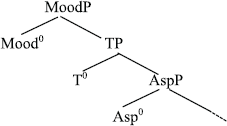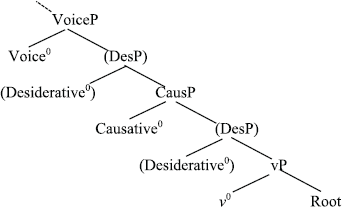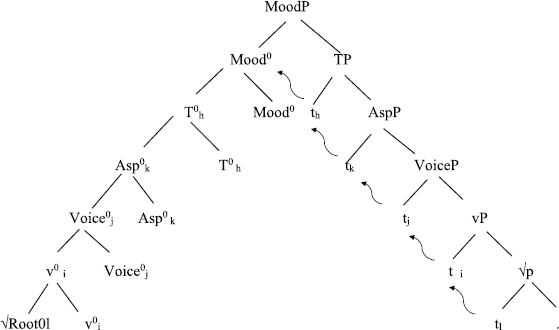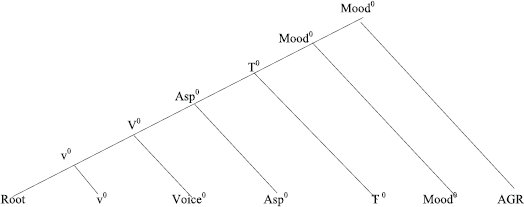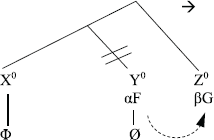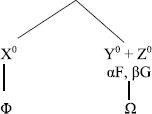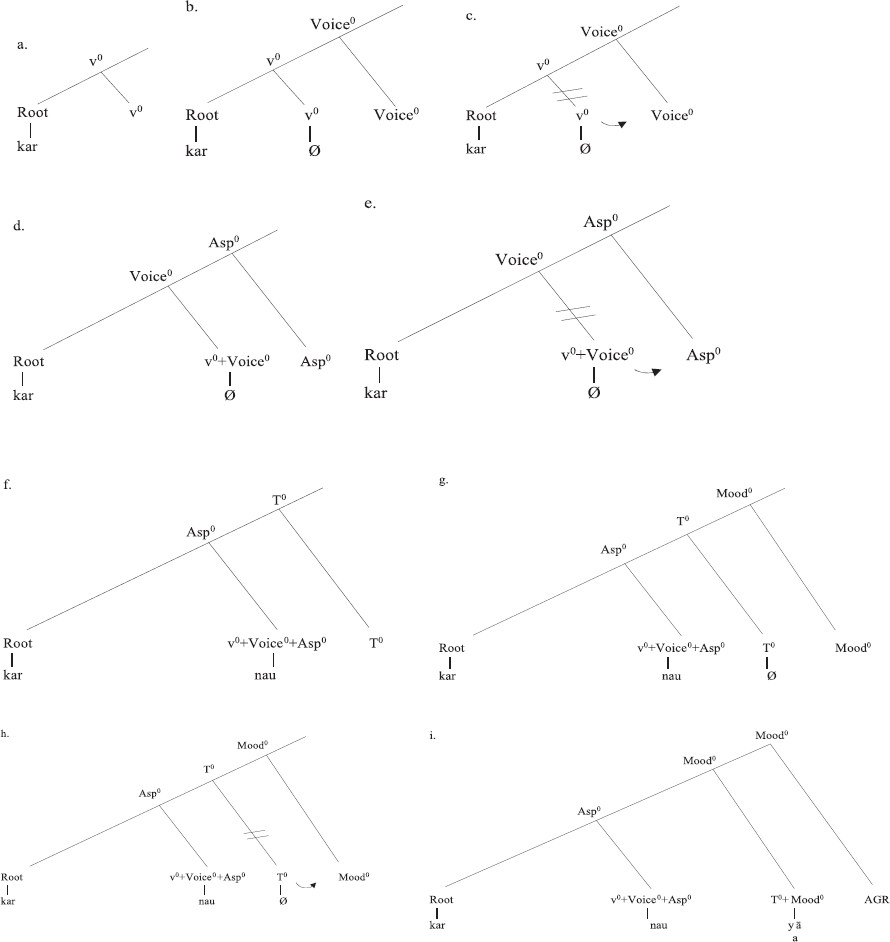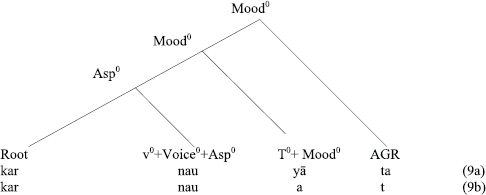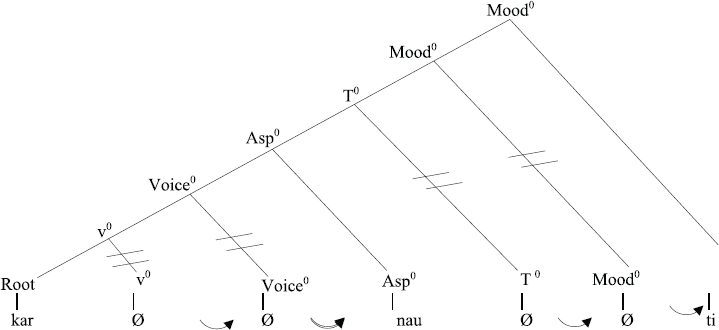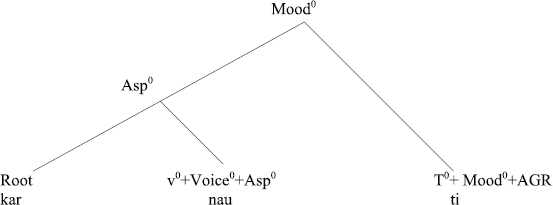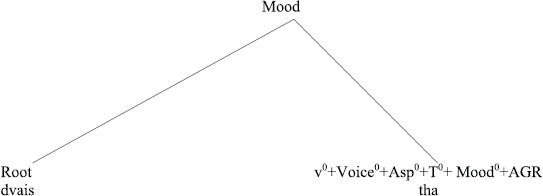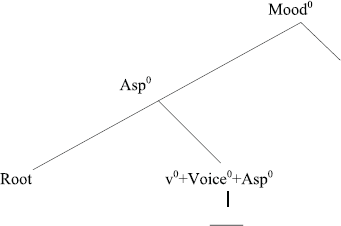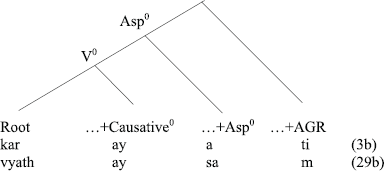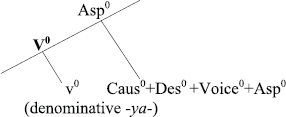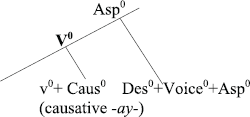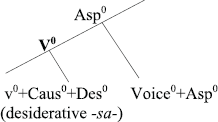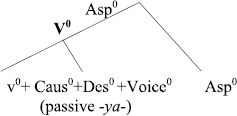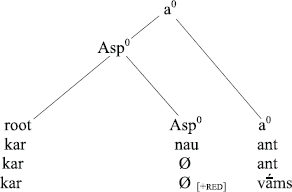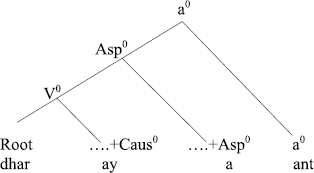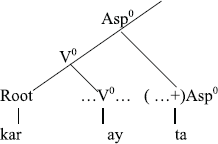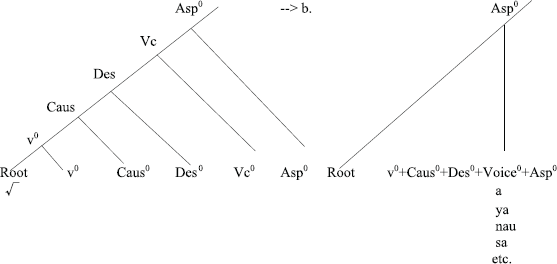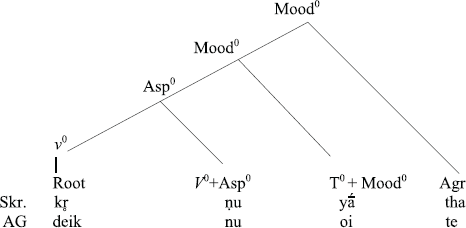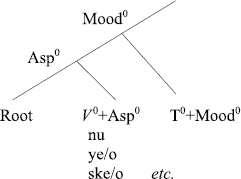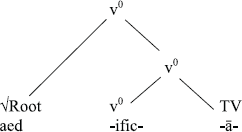1 Introduction
Proto-Indo-European verbal morphology is traditionally described as having an important morpho-phonological distinction between stems ending in a fixed — non-alternating with Ø — vowel (“thematic stems”) and stems without it (“athematic stems”). In thematic stems, in particular, the root is immediately followed either by one of the so-called “thematic suffixes”, i.e. the vocalic suffix *-e- and the vowel-ending suffixes *-ye-, *-se-, etc.1 This paper looks at the morpho-syntactic behavior of the outcomes of these thematic suffixes in three ancient Indo-European languages: Sanskrit, Ancient Greek (henceforth, AG), and Latin. Within Distributed Morphology (henceforth, DM; among others, Halle & Marantz 1993; 1994; Embick 2010), we show that, on the one hand the Sanskrit and AG descendants of the Proto-Indoeuropean (henceforth, PIE) thematic suffixes above are exponents of functional nodes. On the other hand, the Latin root-adjacent vocalic elements -ā-, -ē-, -ĕ-, -ī (i.e., what the grammatical tradition calls “thematic vowels”) developed independently of the PIE thematic suffixes as exponents of “ornamental” nodes, which do not seem to contribute any syntactic or semantic information (Aronoff 1994; Embick 2000: 188). Under DM, they are argued to be generated in the post-syntactic (morphological) component, so that they can trigger morpho-phonological operations, but cannot influence meaning or the internal syntax of the word (Embick 2000; Embick & Halle 2004; 2005; Calabrese to appear a). This article is a further contribution to a recent body of work on the “thematic” formatives in the Indo-European verbal systems which also include Bertocci (2017), Bertocci & Pinzin (2020), Calabrese (2019; to appear a), Grestenberger (2019; 2022). By way of presenting a comparative, theoretical analysis of the root-adjacent vocalic elements of Sanskrit, AG, and Latin, the purpose of the paper is two-fold. First, we seek to clarify the current discussion regarding these pieces in at least these ancient Indo-European languages. In doing this, we also investigate aspects of the verbal morpho-syntax of these three languages. Secondly, we account for the development of the Latin thematic vowels from PIE, insofar as Latin underwent a structural innovation whereby the vowels of some functional nodes lost their syntactico-semantic role and become ornamental pieces to be inserted in dedicated structural post-synctatic positions.
The paper is organized as follows. Section 2 looks at Sanskrit, and consists of three subsections. Section 2.1 gives a sketch of the Sanskrit verbal system. Section 2.2 provides the theoretical background this paper rests upon, and uses the Sanskrit verbal system as a hands-on example to apply the framework to. Section 2.3 investigates the morpho-syntactic behavior of the root-adjacent exponence in the language and aims to show how it realizes fully functional nodes. The next two main sections follow the same internal outline. Section 3 deals with AG verbal morphology and shows that AG root-adjacent exponence is also mainly functional. Section 4 deals with Latin verbal morphology and shows that Latin root-adjacent exponence is ornamental instead. A diachronic account for the development of the Latin ornamental system is also discussed. Sections 5 concludes the paper.
2 Sanskrit
2.1 A sketch of the Sanskrit verbal system
Sanskrit verbs are traditionally organized into three different systems: the present, perfect, and aorist systems, which are distinguished in terms of aspectual features.2 Each system includes mood distinctions: indicative, subjunctive, optative, imperative. Additionally, the indicative mood has tense distinctions between a present and a past.3 The endings display person, number, voice, and tense distinctions.4 The paradigm of the verb kar-nau- ‘make’ in Table 1 reports the basic structuring of the different verbal forms for the three systems.
The forms of this table display a complex surface allomorphy: the root appears as [kar/kr̥/kr] and the internal suffix as [ṇo/ṇu/ṇav]. In order to understand this pattern, one needs to look into Vedic Sanskrit morpho-phonology, and in particular the phenomena of accentuation and [a]-syncope. A typical sample case is the alternation between kr̥-ṇó-t-i/ kr̥-ṇu-yā́-t which also displays the mobile accentual pattern that is typical of this language. Here, the vowel -a- of the suffix -nau- (which surfaces as [no] by monophthongization and [nav] by resyllabification) is syncopated when an accented syllable such as -yā́- follows. The alternant that displays the vowel (-náu- > -nó-) is traditionally called the “full grade”, and the alternant where the vowel is syncopated (-nu-) is called the “zero grade”.7 The relationship between accentual shifts and full/zero grade is rather complex, and cannot be dealt with here (but see Calabrese & Grestenberger 2023 for a recent in-depth analysis). Since accentual mobility is irrelevant to our analysis, we will just focus on zero grade without considering its prosodic conditioning. For the sake of simplicity, we will assume that zero grade is triggered by certain specific suffixes such as the OPT morpheme -yā-, the 2pl.act morpheme -tha, etc. As we will see further below, the one crucial detail here is that while the vowel of some suffixes (“thematic”) never undergoes zero grade, the vowel of other suffixes (“athematic”) does.
Investigation of the cooccurrence restrictions among the different pieces already identified in Table 1 leads to the analysis in (1) where the different pieces appear in their underlying forms, i.e., with the subtraction of the effects of morpho-phonological processes such as monophthongization, accent, zero grade, and resyllabification. Given (1), -nau- (and the relative surface representations: [no], [nav], [nu]) is the exponent of present (imperfective aspect); aprefix- of past tense; -a- of subjunctive mood, and -yā- of optative mood; and -t of the 3rd person singular agreement ending.8 Otherwise, there are null exponents (see below for a more detailed discussion of the feature assignments of the different pieces).9
- (1)
- Root
- Asp0
- T0
- Mood0
- AGR3sg.act
- Present
- kar
- kar
- kar
- nau
- nau
- nau
- a
- yā
- ti
- t
- t
- Indicative
- Subjunctive
- Optative
- Aorist
- kar
- kar
- kar
- aprefix10
- a
- yā
- t
- t
- t
- Indicative
- Subjunctive
- Optative
- Perfect
- ca-kar11
- ca-kar
- ca-kar
- a
- a
- yā
- Indicative
- t
- t
- Subjunctive
- Optative
We are now ready to turn to the exponence of the root-adjacent nodes across systems. In this section, we introduce the exponence of the present system; a more in-depth analysis of this and the other systems is given in the following sections. The grammatical tradition recognizes ten verb classes, depending on the form of the present stem (MacDonnell 1927); they are traditionally divided into two broad groups: thematic (Table 2A) and athematic (Table 2B).
Sanskrit verbal classes (simplified).
| class | PRES stem | Root UR | ||
| A | I | Root in full grade + -a- | bhar-a- | bhar ‘bring’ |
| IV | Zero grade root + -a- | tud-a- | taud ‘thrust’ | |
| VI | Zero-grade root + ya- | ksudh-ya- | ksaudh ‘be.hungry’ | |
| B | II | Root verbs | dveṣ-/dviṣ- | dvais ‘play’ |
| III | Prefixal reduplication on the root | ju-ho-/ju-hu- | hau ‘sacrifice’ | |
| V | nau-suffixation, zero-grade root | stṛ-nau-/ stṛ-nu- | star ‘strew’ | |
| VII | ⟨na⟩-infixation, zero-grade root | yu⟨na⟩k-/ yu⟨n⟩k- | yau ‘join’ | |
| IX | nā-suffixation12 (zero-grade: nī/n) | pu-nā-/pu-ṇī- | pau ‘clean’ | |
The difference between the athematic suffixes (Class V -nau-, Class VII -na-, and VIII -au-) on one side, and the thematic one (Class I -a-, Class VI -a-, and Class -ya-) follows from their zero-grade properties.13 The vowel of thematic suffixes -a- and -ya- never undergoes zero grade. On the contrary, the vowel [a] of as the athematic suffixes -au-, -nau-, -na-, may undergo zero grade when followed by a zero-grade triggering suffix. For example, the 2pl.act ending -tha triggers zero grade in the latter suffixes (2b), but not in the former (2a).14
- (2)
- a.
- Thematic
- tud-á-ti
- thrust-pres-3sg.act
- vs.
- tud-á-tha
- thrust-pres-2pl.act
- b.
- Athematic
- kr̥-ṇó-ti (<kr̥-ṇáu-ti)
- make-pres-3sg.act
- vs.
- kr̥-ṇu-thá
- make-pres-2pl.act
In this paper, we also deal with ‘secondary’ verbs, i.e. verbal forms that are composed of roots and additional verbalizing suffixes (Burrow 1955: 353). For the current purposes, we focus on the passive, causative, desiderative, and denominative forms,15 which we will eventually labeled as VP-shell derivative verbal forms. The passive voice forms are made by adding -ya- to the zero-grade stem (3a). The causative forms add -ay(a)-16 to the root, which undergoes vowel lengthening (3b). The desiderative is formed by adding -sa- to a reduplicated, zero-grade root (3c).17 The denominative form add the suffix -ya- to nouns (3d).
- (3)
- a.
- kr-[i]yá-te
- make-pass.pres-3sg.nact
- ‘s/he is made’
- b.
- kār-áya-ti
- make-caus.pres -3sg.act
- ‘s/he causes to make’
- c.
- cí-kīr-ṣa-ti
- red-make-desid.pres-3sg.act
- ‘s/he desires to make’
- d.
- namas-yá-ti
- homage-denom.pres-3sg.act
- ‘s/he pays homage’
Notice that the final [a] of all of these morphemes is “thematic” in not undergoing zero grade before accented endings: cf. (3d) vs (4), while keeping in mind that 2pl.act -tha is a zero-grade triggering suffix (2).
- (4)
- namas-yá-tha (✘namas-y-thá)
- homage-denom.pres-2pl.act
- ‘you (pl) pay homage’
These suffixes appear to be associated with the present system and are usually morphologically incompatible with other aspectual markers. Combinations of VP-shell derivatives are quite rare, and the ones listed below are apparently the only ones attested (Whitney 1889: 238–239).18 For simplicity, (5) also reports intermediate forms, before morpho-phonological processes—accent, zero-grade, resyllabification, etc.— apply. From these forms, the passive seems to be in an outer position with respect to the desiderative (5a) and the causative (5c), which in turn are in an outer position with respect to the denominative (5e-f). The causative and the desiderative can instead appear in different scopal positions between each other (5b, d).
- (5)
- a.
- Desiderative-Passive
- cikitsyáte
- ci-kit-sa-ya-te
- red-know-des-pass-3sg.nact
- ‘it is desired to know’
- b.
- Desiderative-Causative
- cikīrṣáyati
- ci-kīr-ṣa-aya-ti
- red-make-des-caus-3sg.act
- ‘he causes to desire to make’
- c.
- Causative-Passive
- dhāryáte19
- dhār-ay-ya-te
- carry.on-caus-pass-3sg.nact
- ‘it is caused to carry on’
- d.
- Causative-Desiderative
- dídha̅ray[i]sati20
- di-dha̅r-ay-sa-ti
- red-carry.on-caus-des-3sg.act
- ‘He desires to cause to carry on’
- e.
- Denominative-Causative
- dhūmāyáyati
- dhūmā-ya-aya-ti
- smoke-denom-caus-3sg.act
- ‘s/he causes to smoke’
- f.
- Denominative-Desiderative
- abhiṣisenay[i]sati
- abhi-ṣi-sen-ya-sa-ti
- towards-red-army-den-des-3sg.act
- ‘s/he desires to wage war’
In the next section we derive the morpho-syntactic structure of the Sanskrit verbal forms within the DM framework adopted here, which will also allow us to illustrate the basic aspects of the model.
2.2 A DM analysis of the Sanskrit verbal system
DM (Halle & Marantz 1993; 1994) is a syntax-driven theory of morphology claiming that the distribution of morphological pieces in word formation is syntactically driven. The framework rests upon three main tenets. First, morphemes (roots and affixes), as complex bundles of morpho-syntactic and semantic features, are combined into larger syntactic structures, complex heads. Second, phonological spell-out applies cyclically morpheme-by-morpheme bottom up and includes cyclic Vocabulary Insertion (VI) that assign exponents, i.e., phonological indices, to the terminal nodes of the complex heads, and morpho-phonological and phonological processes that modify the phonological shape of these exponents. Third, such morphological and morpho-phonological operations are governed by locality principles sensitive to these structures (Embick 2010; 2013; Bobaljik 2012). The ultimate goal of this framework is to define the grammatical conditions that constrain morphological exponence under the assumption that morphemes are structure-dependent, syntactic entities. This results in two main corollaries. Firstly, given an independently motivated morpho-syntactic structure, changes in word exponence can only involve changes in the exponents of the terminal nodes of this structure. Furthermore, the structure constrains the analytical choices that can be made insofar as the nature of each morphological piece in the surface string must be assessed in terms of the overall—independently motivated—morpho-syntactic structure of the word. This approach to analytical choices will be crucial in this paper.
We derive the morpho-syntactic structure of the verbal systems of the languages considered here, by assuming the verbal functional structure in (6), along the lines of Wurmbrand (2015) and Cinque (1999).
- (6)
As standard in DM, we also adopt the split VP hypothesis (see Harley 2017 and references therein), and with it a complex structural organization of the VP-shell, which consists of: vP, which assigns the verbal category to the category-unspecified root head of its complement; as such, it can also be a denominative/deadjectival verbalizer; CausP, which introduces causative syntax and semantics; and VoiceP, which controls the presence/absence of the external argument (and consequently assignment of accusative case; Marantz 1991). In addition, the Sanskrit VP-shell may also include a Desiderative0 head (and the relative maximal projection, DesP), which we assume entails a low aspectual head (possibly, akin to a conative head in the parlance of Cinque 1999). As illustrated earlier in (5), it may appear both above and below the causative with different scopal effects. The resulting structure is shown in (7). We will refer to the head nodes in (7) and their exponents as the VP-shell functional nodes and the VP-shell exponents, respectively.
- (7)
The universal hierarchical structure formed by the combination of (6) and (7) is then mapped onto units—X0-complexes—which correspond to morphological words (Embick & Noyer 2001). X0-complexes, are generated by head movement operations. Along the lines of Calabrese & Pescarini (2014), we assume that morphological operations and syntactic derivation are cyclically interleaved. So, head-movement operations, during what we call morphological spell out (Calabrese 2019), may first generate X0-complexes, which can then be targeted by other syntactic head-movement operations such as V-to-C movement. The word-forming head movement operations are the only one of relevance here. As in Calabrese (2019), we assume that the affixal properties of functional heads during morphological spell-out follow from a morphological principle requiring that each functional head X0 in an extended projection, must be adjoined to a root or to a Y0 complex including a root. In this system, syntactic representations in violation of this principle are repaired through operations such as head raising (see Harizanov & Gribanova 2018; for the sake of simplicity, the alternative repair operation of head lowering is not covered in this paper since it is not directly relevant to the analysis developed here). We will not linger further over the technical aspects of head-movement and their justification here. Such a procedure will create the structure in (8a), which omits VP-shell derivatives such as the desirative and the causative just for the sake of graphic simplicity. The node Agr is then adjoined to the highest X0 in the complex verbal head (8b; Halle & Marantz 1993; Bobaljik 2000).
- (8)
- a
- b.
The resulting structure undergoes VI, i.e. the procedure of association between (bundles of) morpho-syntactic features (i.e., functional nodes) and phonological content (exponence), which is assumed to occur cyclically inside out (Bobaljik 2000). Now there is a problem. The X0-complex generated in (8) should include at least six affixes in addition to the root; only three pieces maximally appear in the actual forms in Table 1, as also shown in (9).
- (9)
- a.
- kr̥-ṇu-yā́-ta
- make-pres-OPT-2pl.act
- ‘you (pl.) would make’
- b.
- kr̥-náv-a-t
- make-pres-subj-3sg.act
- ‘(that) s/he makes’
A first possibility is that the lack of overt realization of certain nodes is simply due to syntactic inactivity, i.e., the nodes that not overtly marked are simply absent in the morpho-syntactic representation. Embick & Halle (2005) and Halle (2018) proposed that unmarked features specifications are just syntactically absent in morpho-syntactic representations. A striking case discussed by Calabrese (to appear a) is the exponent of the Latin 1SG.ACT AGR node, which, putting aside the perfect /-ī/ (cf. laudāvī), is -ō in present and future indicative forms (laud-ō ‘I praise’, laudāb-ō ‘I will praise’, laudāver-ō ‘I will have praised’), otherwise -m (laudāba-m ‘I used to praise’, laudāvera-m ‘I had praised’, laude-m ‘(that) I praise (subj.)’, laudāre-m ‘(that) I praise (subj.)’, laudāvisse-m ‘(that) I used to praised (subj.)’, laudāveri-m ‘(that) I praised (subj.)’). The only way to characterize the distribution of -ō is to refer to the feature specifications [–PAST, -IRREALIS]. These are clearly unmarked, yet they must be present when Agreement exponence is inserted. This could not be accounted for if the relevant nodes were not syntactically projected. Zero-exponence (conventionally signaled as -Ø-) seems therefore unavoidable in situations where distributional properties of exponents can only be accounted for by referring to phonologically silent (i.e., null) feature specifications (see Calabrese to appear a, for further arguments). On the other hand, adoption of zero-exponence leads to theoretical underdetermination, which allows for a proliferation of equally possible theories (among others, Anderson 1992; Marantz 1997; Trommer 2012; Dahl & Fabregas 2018). To exemplify, consider the Sanskrit present suffix -nau-. It appears in root-adjacent position and competes with other pieces occurring in the same position; thus not only with the other present system markers in Table 2, and the VP-shell derivative suffixes in (3)–(5), but also the aorist -Ø- and -s-, as we will see below. Its distribution can then be characterized by the features [–DEN, –PASS, –CAUS, –PFV]. There is no other piece whose distribution depends on one of them. Once the featural distribution of an item such as -nau- is established, one must determine its structural distribution: the insertion site of the exponent. If the specification(s) belong(s) to a single terminal node, there is no issue: the exponent is inserted into this terminal node. The situation is more complicated if the Vocabulary Item includes specifications belonging to multiple terminal nodes. This is the case of -nau-. In this form, at least three nodes are realized by the single piece -nau-; so, potentially only one node is overtly realized; the other two are silent. At its current version, DM in principle allows the practitioner to analyze -nau- as realizing any of the existing nodes above the root (10), with no independent way to prefer one solution to the others (Pullum & Zwicky 1991):
- (10)
- a.
- … [Asp [Voice [v [kar] -nau ]v0 Ø ]Voice0] -Ø-]Asp0 …
- b.
- … [Asp [Voice [v [kar] -Ø- ]v0 -nau-]Voice0] -Ø-]Asp0 …
- c.
- … [Asp [Voice [v [kar] -Ø- ]v0 -Ø- ]Voice0] -nau-]Asp0 …
To account for situations like this, an operation of node fusion, which bundles nodes together, was proposed in early models of DM (e.g., Halle & Marantz 1993).
- (11)
- … [Asp +Voice+ v [kar] -nau-]v0+Voice0+Asp0 …
Fusion, however, suffers from a look-ahead problem insofar as it must occur before VI so to allow insertion of the relevant fused exponent (Chung 2007; 2009). An alternative operation that can directly connect fusion and zero exponents is null-node pruning. This procedure consists of delinking nodes where Ø’s are inserted when independently-motivated terminal nodes lack a phonological realization. As Calabrese (2019) shows, null-node pruning is independently required to (a) simplify the phonological realization of morphosyntactic structures; and (b) account for the convergence of complex morphosyntactic structures and their simplex phonological realization. Additionally, (c) it explains why phonologically null exponents — regardless of their marked/unmarked status — appear not to act as interveners for morphological locality. Pruning applies as in (12). First, the terminal node Y0 is assigned a Ø during VI. As such, Y0 is detached from its immediately dominating node, but is not deleted. Its features become floating and are merged with an adjacent higher terminal node if there is one. The lower adjacent node X0 has already undergone VI – in (12), Φ is an overt exponent that is already inserted; the higher adjacent node Z0 is instead yet to be realized, thus being the available docking site. As a result, the nodes Y0 and Z0 fuse into Y0 + Z0, which undergoes VI again and get assigned the exponent Ω.
- (12)
- a.
- b.
Thus, what matters is the pattern of overt exponence. Given an independently motivated morpho-syntactic structure such as the hierarchy in (8b) and the distribution of overt exponents, zero exponent insertion and bottom-up cyclic pruning can generate the relevant simplified morpho-syntactic structures. Once null exponents are identified, Øs can be considered as devices triggering pruning and subsequent fusion and we will be using them with this function. The resulting bundles will include features of nodes that do not have overt exponence despite being morpho-syntactically active.21 Pruning could be thought of as triggered by the UG filter in (13) which disallows a terminal node exhaustively dominating a null exponent, i.e. phonologically realized as Ø (see Arregi & Nevins 2012; Calabrese 2019, for a theory of morphology including morphological filters and repairs):
- (13)
The constraint target morpho-syntactic configurations. Null exponents are independently needed as argued earlier to account for the silence associated with certain morphosyntactic features. Null exponents can be cyclically inserted during Vocabulary Insertion as motivated earlier. Once these null exponents are inserted in terminal nodes, they violate (13). But then they are immediately removed by pruning as a repair. This theory has consequences on the structure of the VIs and on the feature specification to be used in them. In fact, due to (13), the use of Ø is costly. We propose a principle governing VI composition:
- (14)
- Vocabulary Items can only assign overt exponence.
It follows that given an overt exponent whose distribution involves the features of more nodes, it must be postulated in such a way that it maximally expones the entire sequence of nodes and must therefore be inserted in the highest node.22 Thus, in the case of -nau- whose distribution is characterized by the feature specifications [–DEN, –PASS, –CAUS, –PFV] belonging to different nodes, the most economical VI requested by (14) will be (15). Zeros, on the other hand, are assigned only by an universal default elsewhere operation which applies to all nodes not receiving overt exponence.23
- (15)
- nau <--> [–PFV]/ rootV, VIII] ___]Asp
Let’s see how this works for Sanskrit. In the morpho-syntactic structure in (8) overt exponents are cyclically inserted bottom-up, with Ø’s being inserted at terminal nodes with no overt phonological realization. Taking into consideration the Sanskrit forms in (1), one observes that only Asp0 and Mood have overt exponence (16), whereas the other nodes are assigned zeros (16). These zero-exponed nodes are then pruned; feature floating and docking will generate the cyclic derivation in (17), where v0 and Voice0 are pruned and fused with Asp0; and T0 is pruned and fused with Mood0 (post-VI morpho-phonological processes are not considered here).
- (16)
- a.
- b.
- c.
- d.
- (17)
The resulting structure after insertion of an overt exponent in AGR is (18):
- (18)
If also Mood0 has zero exponence as for example in indicative forms where only Asp0 has overt realization (e.g., kar-ṇáu-ti > kr̥nóti, ‘s/he makes’), the resulting structure is derived as in (19) and (20). (Again post-VI morpho-phonological processes are glossed over here.)
- (19)
- (20)
There are cases in which Asp0 is non-overt (e.g., dviṣthá ‘you (pl) hate’), therefore all of the functional nodes are fused together under Mood0 as in (21):
- (21)
In the next section, we assume the basic structures in (18), (20), and (21), which will then be revised later on, when the secondary verbs are treated (sec. 2.3.1). This short theoretical digression served as an introduction to the theoretical framework the remainder of the paper couches in. From our perspective, what matters is the pattern of overt exponence. Given an independently motivated morpho-syntactic structure such as that in (8) once the distribution of overt exponents has been established, insertion of zeros and cyclic pruning will generate the relevant simplified morpho-syntactic structures.
2.3 The functional status of the Sanskrit root-adjacent exponence
Let us now consider the exponence of the root-adjacent nodes in more detail in the present, aorist, and perfect systems. As already mentioned above in Section 2.1, Sanskrit root-adjacent exponence of the present system of the primary verbs consists of the suffixes: -a-, -ya-, -nau-, -na-, and -Ø- (we will discuss the secondary verbs in the next section). As observed above, the suffixes -a- and -ya- are traditionally called “thematic” suffixes, insofar as they never undergo zero grade (22A). The suffixes -nau- and -na- are instead called “athematic”, insofar as they may undergo zero grade (22B). Strikingly, all of these suffixes never co-occur together, which suggests that they all compete for the same structural position.
- (22)
- A.
- Thematic classes.
- UR
- /[[bhav]Root – a]Asp -/
- / [[taud]Root - a]Asp -/
- / [[daiv]Root - yá]Asp -/
- >
- >
- >
- Present stem
- [bhava-]
- [tuda-]
- [divya-]
- gloss
- ‘be’
- ‘strike’
- ‘play’
- verb class
- I
- VI
- IV, X
- B.
- Athematic classes.
- UR
- /[[raudh]Root – na]Asp -/
- /[[star]Root – nau]Asp -/
- /[[dvaiṣ]Root - Ø]Asp -/
- >infixation
- >
- >
- Present stem
- [ru⟨na⟩dh-/ru⟨n⟩dh-]
- [str̥nau-/str̥nu-]
- [dvaiṣ-/dviṣ-]
- gloss
- ‘obstruct’
- ‘strew’
- ‘hate’
- verb class
- VII, IX
- V, VIII
- II
We now expand on the root-adjacent exponent of the perfect and the aorist systems. The perfect system is characterized by root partial reduplication (not discussed here) and has a suffixal null exponent (23).
- (23)
- tu-tud-Ø-á
- red-thrust-prf-2pl.act
- ‘you (pl) have thrusted’
The aorist system may be formed in a number of ways; here we only consider a subset of them for reasons of space.24 The athematic root aorist does not have an overt aspectual exponent (24a). The “thematic” aorist is formed with suffixal -a- (24b). The s-aorist has the aspectual exponent -sa- (24c) or -s- (24d).
- (24)
- a.
- á-kar-Ø-ta
- aug-make-aor-2pl.act
- ‘you (pl) made’
- b.
- á-vid-a-ta
- aug-find-aor-2pl.act
- ‘you (pl) found’
- c.
- á-dik-sa-ta
- aug-point-aor-2pl.act
- ‘you (pl) pointed’
- d.
- á-bhār-s-ta
- aug-bear-aor-2pl.act
- ‘you (pl) bore’
Perfect and aorist exponents may never co-occur with one another, and with any of present system exponents. The affixes occurring in the present system indeed never occur with affixes of the other two systems in the same verb (25).
- (25)
- a.
- b.
- c.
- d.
- present stem
- bhi⟨n⟩d-/bhi⟨na⟩d-
- kr̥-nau-/kr̥-nu-
- vr̥k-a-
- ján-a-
- aorist/perfect stem
- bhid-/bhaid-
- kar-/kr̥-
- vr̥k-śa-
- jan-
- gloss
- ‘split’
- ‘make’
- ‘tear’
- ‘generate’
Accordingly, potential forms showing affixes of the two systems such as ✘bhi⟨n⟩d-sa-, ✘bhi⟨n⟩d-a- (25a); ✘kr̥-nu-sa-, ✘kr̥-nu-a- (25b); ✘vr̥k-a-sa-, ✘jan-a-sa- (25c, d), etc., are not attested. It follows that the present, aorist, and perfect suffixes appear to compete for the same morpho-syntactic position. Given their semantics, we suggest that all of them are exponents inserted under Asp0 as in (26):
- (26)
One can therefore propose that Asp is realized by (27).25 Notice that -a- (i.e., what the tradition labels as the “thematic vowel”) is here treated as the elsewhere exponent of the functional Asp (27f).26,27
- (27)
- a.
- b.
- c.
- d.
- e.
- f.
- g.
- -sa-
- -s-
- -ya-
- -na-
- -nau-
- -a-
- -Ø-
- <-->
- <-->
- <-->
- <-->
- <-->
- <-->
- elsewhere
- [+PFV, –STATIVE]Asp / root^] ___
- [+PFV, –STATIVE]Asp
- [–PFV]Asp / root-ya-(IV, X) ] ____
- [–PFV]Asp / root-na- (VII, IX) ] ____
- [–PFV]Asp0 / root-nau- (V, VIII) ] ____
- [ ]Asp
- where ^={daiś (24c), …}
It is worth underlining that, in this analysis, Ø is treated as the default exponent for any functional node lacking any more specified exponence rule (27g), as suggested by its wide distribution across functional heads (Voice, Asp, T, and Mood) and featural configurations. As such, (27g) can be considered an operation of default assignment of null exponence and not a Vocabulary Insertion rule.
2.3.1 The behavior of VP-shell derivatives in the Sanskrit verbal system
Up to this point, we have considered only primary verbs involving a null (and therefore pruned) verbalizer. We now extend our analysis to the secondary verbs, which, as introduced in Section 2.1, involve an overt exponent intervening between the root and the higher functional nodes. As we will see, they will provide further evidence for the analysis argued above in (27). The secondary verbs are characterized by the overt morphological realization of what we called earlier the VP-shell functional nodes. These verbs include passives in -ya-, causatives in -ay(a)-, denominals in -ya-, and desideratives in -sa- (see Section 2.1 for examples). In the protolanguage, these suffixes seem to be associated with present system and were morphologically incompatible with other aspectual markers (Ringe 2006: 27–35; Sihler 1994: 494)—the situation that still appears to characterize AG, as discussed later. In the model developed here, this follows if we assume that also the VP-shell nodes had zero exponence and underwent the pruning and the docking operations discussed above. It follows that they were bundled with Asp and their exponents were inserted there. Hence, they were inserted in a node including v0+Causative0+Desiderative0+Voice0+Asp0 features, in particular the aspectual feature specification [–PFV]; see also (43) further below.28 Thus, the VI in (28) can be postulated for PIE:
- (28)
- *-ye-
- *-ey-29
- *-se-
- <-->
- <-->
- <-->
- [+DENOM, –PFV]Asp0
- [+CAUS, –PFV]Asp0
- [+DES, –PFV]Asp0
There is evidence, however, that shows that the VP-shell exponents became able to co-occur with aspectual exponents at some point of the history of Sanskrit. As a matter of fact, these suffixes may co-occur, though occasionally, with aspectual exponent in this language. For example, the causative of the verb vyath- ‘suffer’ (29b) and the denominative of the noun pāpa ‘evil’ (30b) display an overt realization of perfective aspect (aorist) (cf. 29a).
- (29)
- a.
- a-vyath-[i]ṣa-m
- aug-suffer-aor-1sg.act
- ‘I suffered’
- b.
- a-vyath-áy-[i]ṣa-m
- aug-suffer-caus-aor-1sg.act
- ‘I disturbed’
- (30)
- a.
- pāpa-yá-tha
- evil-denom.pres-2pl.act
- ‘you (pl) lead into evil’
- b.
- pā́pa-y-[i]ṣ-ta
- evil-denom-aor-2pl.act
- ‘you (pl) led into evil’
In forms like those in (29)–(30), the causative exponent must have been reanalyzed as involving only its VP-shell features so that they were inserted in their dedicated positions in this domain. Therefore, there was no longer bundling of the VP-shell nodes with Asp0; hence the latter node could get its own dedicated exponent. Note, moreover, that in (29) above, the causative appears as -ay- before the aorist suffix -s-, instead of -aya- (3b). The best way to account for these facts is to assume that -ay- is the actual causative suffix and -a- is the default exponent of the [–PFV] Asp node.30
- (31)
- a.
- b.
- -ay-
- -a-
- <-->
- <-->
- [+caus]/ [ ____ ]v
- [ ]Asp
This segmentation has two major advantages. First, it readily explains the form -ay- of the causative when it is not adjacent to [–PFV] Asp0 as in the case of the aorist forms seen above:
- (32)
Second, it accounts for why the causative realizes as -ay- when it is not adjacent to [–PFV] Asp0 but it occurs before other VP-shell elements (33). In this case, aspectual -a- only appears after the desiderative exponent.31 This may also suggest that the final -a- surfacing in VP-shell exponents may be considered the exponent of the [–PFV] Asp0 node although more research is needed on this point.
- (33)
- dí-dhār-ay-[i]sa-a-ti
- red-bear-caus-des-pres-3sg.act
- ‘s/he desires to cause to bear’
- (34)
An independent way to prove that the structures in (32), (34) are on the right track in treating VP-shell suffixes below Asp0 comes from participial morphology. For purely explanatory purposes, in the discussion above we use a single VP-shell bundled node, especially since there is usually a single VP-shell exponent (with the exception of few forms discussed above in ex. 5). As this bundled node may vary in the featural specification, we will refer to it generically – albeit somewhat improperly since this node can also realize a desiderative – as V0 (bolded in the structures below):
- (35)
- a.
- b.
- c.
- d.
Here we discuss two kinds of participles. The first kind involve participles -ant- (for the present and aorist active systems) and in -vaṃs- (for the perfect active system), see Table 3. We can assume that these participial suffixes are in an outer position with respect to the aspectual node, perhaps in an adjectival head a0 (36):
Participial forms in Sanskrit.
| present | aorist | perfect | root |
| kr̥-ṇv-ánt-am do-pres-prtcpl-acc.m.sg |
kr-ánt-am do-prtcpl-acc.m.sg |
ca-kr̥-vā́ms-am red-do-prtcpl-acc.m.sg |
kar/kr ‘do/make’ |
| bháv-ant-am be-prtcpl-acc.m.sg |
-- | ba-bhū-vā́ṃs-am red-do-prtcpl-acc.m.sg |
bhav ‘be’ |
| bhi⟨n⟩d-ánt-am split⟨pres⟩-prtcpl-acc.m.sg |
bhid-ánt-am split-prtcpl-acc.m.sg |
-- |
bhid ‘split’ |
- (36)
Such a claim seem to be confirmed by the fact that VP-shell derivative suffixes (and with them the aspectual information) also appear in the inner constituent of the participles in Table 3 so that we can assume the structure in (38) for the causative in (37a), but the same holds for the forms in (37b) and (37c):32
- (37)
- a.
- dhār-ay-ánt-am
- bring-caus-prtcpl-acc.m.sg
- ‘him who supports’
- b.
- namas-y-ánt-am
- homage-denom-prtcpl-acc.m.sg
- ‘him who pays homage’
- c.
- vivā-s-ánt-am
- win-des-prtcpl-acc.m.sg
- ‘him who would like to win’
- (38)
The verbal participle forms discussed above are to be contrasted with the stative adjectival forms usually used as perfect passive participles (Renou 1996; cf. also AG “verbal adjectives” below). These forms are characterized by the suffix -ta- in (39) that usually appears to be directly attached to the root (which undergoes zero grade):
- (39)
- a.
- piṣ-ṭá- (root: paiṣ)
- crush-prtpl.m/n.sg
- ‘crushed’
- b.
- iṣ-ṭá- (root: aiṣ)
- desider-prtpl.m/n.sg
- ‘desired’
Crucially, as compared to the participal suffixes, -ta- never appears with an aspectual exponent: e.g., for the verb kar ‘to make’, the forms ✘krnutá (from the present stem: kr-nau-), or ✘cakr̥tá- (from the perfect stem of kar: ca-kr̥-) are not attested whatsoever. The only possible form is kr̥tá- ‘made’, in which the suffix -ta- is directly attached to the root, which undergoes zero grade, and no further exponent appears in between. The most plausible hypothesis is then to postulate that the suffix -ta- found in the Sanskrit stative adjectives is inserted in the Asp0 node as in the structure in (40), which account for why -ta- can co-occur with no other aspectual exponent.33
- (40)
In contrast, notice that -ta- can appear with VP-shell derivative suffixes. As (41) shows, -ta- may surface after causative -ay- (41a) and denominative -ya- (41b), both reduced to [i] (due to zero grade); and desiderative -sa- (41c), where [i] is epenthetic.
- (41)
- a.
- kār-i-tá < *kār-ay-ta
- make-caus-prtcpl.m/n.sg
- ‘caused’
- b.
- bham-i-tá- < *bhama-ya-ta
- wrath-den-prtcpl.m/n.sg
- ‘enranged’
- c.
- mīmāṃ-s[i]-tá- < *mimaṃ-sa-ta
- think-des-prtpl.m/n.sg
- ‘pondered’
The compatibility of -ta- with VP-shell derivative suffixes, and its incompatibility with any aspectual marker points to a structure (42) where the inner constituent of the aspectual -ta- only includes a V0-node.
- (42)
To conclude, there is convergent evidence for a structure with an independent VP-shell node below Asp0. Verbal participle forms in ant- and -vaṃs suggest the presence of an inner constituent including both V0 and Asp0, contained in its turn in an outer constituent a0. Stative ta-adjectives, on the other hand, suggest the presence of an inner constituent including only V0. The fact that ta-adjectives are incompatible with markers such as -nau-, -na-, -a-, -sa-, while co-occuring with a VP-shell elements argues that these markers are actually aspectual. Thus, they can appear in the inner constituent of the verbal participles, but not in the inner constituent of the stative adjectives. The same evidence shows that they are in a different morpho-syntactic position with respect to the VP-shell verbalizers like the causatives -ay-, the denominative -ya-, and the desiderative -sa- elements, which can occur inside the stative adjective -ta.
In primary verbal forms, i.e., in forms that are non causative, non-denominative and non-desiderative forms, the VP-shell heads are realized as Ø, which are pruned and fused cyclically up to the first higher non-null exponent. In these cases, the VP-shell and Asp0 nodes are bundled together as shown in (43), which is precisely the structure we are assuming here.
- (43)
- a.
On the basis of the evidence above, we therefore argue that the Sanskrit vocalic suffix -a- -- i.e., what the tradition calls the “thematic vowel” – is a functional exponent realizing morpho-syntactic features under Asp0. As we will see, this is much different from Latin thematic vowels, which do not functionally contribute to the verbal spine; rather they are ornamental entities. But before going into Latin, we now turn to AG, which, as we will see, displays a similar configuration as Sanskrit.
3 Ancient Greek
3.1 A sketch of the AG verbal system
AG verbal system is organized similarly to Sanskrit, i.e. in the present, aorist, and perfect systems. Comparison of the Sanskrit forms in (1) with the AG counterparts (44) leads one to plausibly assume the common morpho-syntactic structure, repeated in (45) below, in which the VP-shell V0 and Asp0 nodes on one side, and the T0 and Mood0 nodes on the other are bundled in two separate nodes as resulting from the null pruning operation proposed above (section. 2.2).34
- (44)
- a.
- deik-nú-oi-te
- show-pres-opt-2pl.act
- ‘you (pl.) would show’
- b.
- deik-nú-ē-te
- make–pres–subj–2pl.act
- ‘(that) you (pl.) show’
- (45)
As we did above for Sanskrit, in the following section, we aim at providing independent evidence for the V0+Asp0 node bundle by analyzing the morpho-syntactic behavior of all root-adjacent morphemes and their realizational patterns.
3.2 The functional status of the AG root-adjacent exponence
Similar to Sanskrit, the AG present system consists of two conjugations: the thematic and athematic conjugations. The thematic conjugation displays a mid vowel in the present forms, right between the root and the endings. This is often called “thematic vowel”. It surfaces as -o- in front of nasal-initial endings (46b), and as -e- elsewhere (46a). The athematic conjugation lacks such vowel (47), regardless of the shape of the rightward suffix.
- (46)
- a.
- lū́-e-te
- solve-“tv”-2pl.act
- ‘you (pl.) solve (pres. ind.)’
- b.
- lū́-o-men
- solve-“tv”-1pl.act
- ‘we solve (pres. ind.)’
- (47)
- a.
- tíθe-te
- put-2pl.act
- ‘you (pl.) put (pres. ind.)’
- b.
- tíθe-men
- put-1pl.act
- ‘we put (pres. ind.)’
Verbs are classified in classes depending on the form of the verb in the present system (cf. Smyth 1956; Sihler 1994).35
AG verb classes (simplified).
| class | pres stem | root | ||
| A | I | Vowel-, diphthong-, consonant-final root. | tima-e/o- | tima ‘honor’ |
| II | Apophonic [-sonorant]-final roots. | leip-e/o- | lip/leip/loip ‘leave’ | |
| III36 | Labial-final roots + *ye > -pt- | kopt-e/o- | kop ‘hit’ | |
| IV | Obstruent-final roots + *ye- | tass-e/o- | tak ‘order’ | |
| V | root + -ne/o- | dak-ne/o- | dak ‘bite’ | |
| VI | root + -(i)ske/o- | eur-iske/o- | eur ‘find’ | |
| VII | root + -e- | dok-e-e/o- | dok ‘believe’ | |
| VIII | irregular roots | hora-e/o- | hora-/op-/Ϝeid- ‘see’ | |
| B | IX | root verbs | ϕē- | ϕē/ϕa ‘say’ |
| X | reduplicated forms | di-do- | dō/do ‘give’ | |
| XI | root + nu | deik-nu- | deik ‘show’ | |
As in Sanskrit, the difference between thematic and athematic conjugation disappears in the aorist and perfect systems. The aorist may have different formations. The athematic root aorist does not have an overt aspectual exponent, and it is essentially conveyed by the full grade of the root (“aorist III”; 48a). The “thematic” aorist is formed with the suffix -e/o- and the zero grade of the root (“aorist II”; 48b). The sigmatic aorist is formed with the suffix -sa- (“aorist I/weak”; 48c).
- (48)
- a.
- é-bē-Ø-men (pres.: báin-o-men)
- aug-go-aor-1pl.act
- ‘we went’
- b.
- e-líp-o-men (pres.: léip-o-men)
- aug-leave-aor-1pl.act
- ‘we left’
- c.
- e-déik-sa-men (pres.: déik-nu-men)
- aug-show-aor-1pl.act
- ‘we showed’
The perfect is mainly characterized by root partial reduplication and may be realized as -ka-, usually usually associated with full grade—also called normal grade— of the root (49a); or -a-, see (49b) where the root vowel undergoes backing and rounding, the so called o-grade, (leip- > loip-).
- (49)
- a.
- pe-phán-ka-men (pres.: pháin-o-men)
- red-appear-prf-1pl.act
- ‘we have appeared’
- b.
- le-lóip-a-men (pres.: léip-o-men)
- red-leave-prf-1pl.act
- ‘we have left’
If we look at the overall distribution of the suffixal vowel -e/o-, we notice that in the present system it is complementary on one side to that of suffixes such as -(a)no/e- (e.g., amart-ano-men ‘we make mistakes’), *-ye/o- (which surfaces in a number of forms: e.g., *tak-ye/o- > tasse/o-: tass-o-men ‘we order’), and -ske/o- (e.g., eur-isko-men ‘we find’);37 and on the other to that of other suffixes such as -nu- (e.g., deik-nu-men ‘we show’, but ✘deik-nu-o-men38) and -Ø- (e.g., ti-the-Ø-men ‘we put’, but ✘ti-the-o-men). This distribution is similar to what we have already seen for Sanskrit, with a crucial difference: in AG zero grade was specific to the root only (rather than being applicable to suffixes too, as in Sanskrit). As a consequence, AG did not adopt the Sanskrit distinction between “thematic” and “athematic”, which essential hinges on the applicability of zero grade onto a given suffix. Rather, “thematicity” in AG ended up referring to the mere presence of the “thematic” vowel -e/o- in the root-adjacent exponent. The parallelism between AG, Sanskrit, and PIE root-attaching affixation is shown in Table 5 below.
In addition, all these suffixes are in complementary distribution with morphemes of the aorist and the perfect systems we have seen above: -(s)a- (50a) and -(k)a- (50b).39
The root-adjacent [–PFV] “thematic” (th.) and “athematic” (ath.) exponence across the three languages.
| Greek | Sanskrit | PIE | |||||
| [lu]Root | -e/o- | th. | [tud]Root | -a- | th. | *-e | th. |
| [tak]Root | -ye/o- | [ksudh]Root | -ya- | *-ye | |||
| [eur(i)]Root | -ske/o- | N/A | *-skē- | ||||
| [amart]Root | -(a)ne/o- | [pu]Root | -na- | ath. | *-ne | ath. | |
| [deik]Root | -nu- | ath. | [kar]Root | -nau- | *-new | ||
| [the]Root | -Ø- | [dvais]Root | -Ø- | *-Ø | |||
- (50)
- a.
- e-lū́-sa-men
- aug-solve-aor-2pl
- ‘I solved’
- b.
- le-lú-ka-men
- red-solve-prf-2pl
- ‘I have solved’
The semantics of all of these suffixes suggests that, as in Sanskrit, they are inserted under the Asp0 node.
3.2.1 The behavior of VP-shell derivatives in the AG verbal system
In our analysis of Sanskrit, crucial evidence for the status of root-adjacent suffixes and for the structural organization of the low verbal functional field was provided the Sanskrit secondary verbs including causatives, denominatives, and desideratives. AG has a rather minimal VP-shell, basically consisting of the sole denominal verbalizer *-ye/o-, which attaches to either consonant-final (e.g., phylass-ō < *phylak-ye ‘I guard’; cf. phylak-s ‘guardian-NOM.M.SG’) or vowel-final noun bases (e.g., tim-a-ō < *tim-a-ye ‘I honor’; cf. tim-ē ‘honor-NOM.F.SG’). Under the assumption that the PIE VP-shell nodes were originally bundled together with the Asp0 nodes, *-ye/o- is the PIE exponent of the bundled node of the denominative verbalizer and [–PFV] Asp0. A major difference between the AG and Sanskrit verbal systems is that in the latter there are some exceptions to the expected V0+Asp0 bundling (see Section 2.3.1), whereas in the former the bundled V0+Asp0 node is constant throughout the verbal system. We now show that, albeit this hindering fact, AG VP-shell derivatives may still provide insights on the nature of the “thematic” vowel -e/o-.
Denominative verbs form the bulk of AG “contract verbs” (verba contracta), i.e. verbs that involve vowel coalescence between a root-adjacent vowel (which may be either part of the root or the suffix of another node), and a structurally higher vocalic element.40 In the case of the denominative verbs, the root-adjacent derivative is a nominal suffix and the higher element is the imperfective verbalizer *-ye/o-, which we are assuming is the exponent of the bundled V0+Asp0 node.41 These verbs are traditionally grouped into three etymological groups, based on the quality of the stem-final vowel (Sihler 1994: 521 f.). Most a-verbs derive from ā-final nominal bases (<*-eH2-) declension. The e-verbs are formed by o-final nominal stem (oike-ō < *oiko-ye-: oikos ‘house’),42 and nominal bases that lost the original root-final -s- intervocalically (tele-ō < *teles-ye-: telos ‘goal’). Finally, the o-verbs are a Greek innovation, whose origin is unclear. In Table 6, we provide a small sample of these verbs to illustrate the bundling between the denominal verbalizer and the Asp0 features. In fact, after the noun markers, i.e., -a-, -e-, -o-, there appears to be just a single morpho-syntactic position where both V0 and Asp0 features are contained, i.e., -e/o- (present stem) vs. -sa- (aorist stem; the perfect stem is not shown as it is essentially parallel to the aorist stem):
AG verba contracta.
| Verb Group | Noun base | root-n-“tv”-1pl.act | aug-root-n-aor-1pl.act |
| -a- | tim-a- ‘honor’ |
tim-a-o-men ‘we honor’ |
e-tim-ē-sa-men43 ‘we honored’ |
| -e- | oik-o- ‘house’ |
oik-e-o-men ‘we house’ |
oik-ē-sa-men44 ‘we housed’ |
| -o- | doul-o- ‘slave’ |
doul-o-o-men ‘we enslave’ |
e-doul-ō-sa-men ‘we enslaved’ |
The morpho-syntactic structuring we see above can be accounted for as follows. In vowel-final nominal roots ending in *-eH1/2 (51), the glide of the denominal verbalizer *-ye/o- is deleted in intervocalic position (GD; e.g., *tim-a-ye- > *tim-a-e-), thus feeding cross-boundary vowel coalescence (VC; *tim-a-e > tim-ā-). In consonant-final noun roots (51), the glide of the verbalizer triggers palatalization (PAL) and/or gemination (GEM) of the previous consonant, and is then deleted e.g., elpid-ye- > elpiz-o ‘I hope’; phylak-ye- > phylass-o ‘I guard’ (see also fn. 33).
- (51)
The fact that V0 and Asp0 are bundled in AG readily explains why the shape of the same stems are different in the aorist/perfect systems in Table 6. As the associated features change, the compatible realizations also change: -sa-, -ka-, -a-, -Ø-, all feed a number of processes such as organic lengthening (OL): e.g., aor. *tim-a-sa-men > tim-ē-sa-men (52a); or coronal deletion (CD) and compensatory lengthening (CL): aor, *elpid-sa-men > elpī-sa-men ‘we hoped’ (52b).
- (52)
We therefore claim that, similar to Sanskrit, the AG suffix -e/o- (> PIE *-ye-), along with the other root-adjacent suffixes (-nū-, -ske/o-, -sa-, -ka-, -ane/o-), are all realizations of a functional node of the V0+Asp0 node, which resulted from the null-pruning operation discussed above. In (53) below, we give the summary list of Vocabulary Items our analysis argues for and the relative morpho-syntactic structure.
- (53)
- a.
- i.
- ii.
- iii.
- iv.
- v.
- -nu-
- -ye/o-
- -(i)ske/o-
- -sa-
- -ka-
- <-->
- <-->
- <-->
- <-->
- <-->
- [–pfv]V+Asp/ [root]XI __
- [–pfv]V+Asp / [root]III, IV __
- [–pfv]V+Asp / [root]VI __
- [+pfv]V+Asp
- [+pfv, +stative]V+Asp
- b.
We can further test this claim by looking at AG participial formations. Similarly to Sanskrit, AG presents two kinds of participles.45 The first type consists of the suffixes -nt- (present/aorist active), -ot- (perfect active), and -men- (middle-passive), which seem to attach to constituents involving the Asp node (54). For these forms, we may assume a structure akin to (38), in which the participial suffix is inserted at a0. The second type consists of the “verbal adjectives” in -t- (conveying possibility) and -te- (conveying necessity); they seem to directly attach to a minimal constituent excluding the Asp node (54). For this reason, they may be akin to Sanskrit -tá (39), and arguably inserted at Asp0 as in (40).
- (54)
- a.
- lú-o-nt-os
- solve-pres-prtcpl-gen.m/n.sg
- ‘of him/it who solves’
- b.
- lū́-sa-nt-os
- solve-aor-prtcpl-gen.m/n.sg
- ‘of him/it who solved’
- c.
- le-lu-k-ót-os
- red-solve-prf -prtcpl- gen.m/n.sg
- ‘of him/it who has solved’
- (55)
- a.
- lu-t-ós
- solve-prtcpl-nom.m/n.sg
- ‘untiable’
- b.
- lu-té-os
- solve-prtcpl-nom.m/n.sg
- ‘he/it that must be solved’
As such, the constituent shape that these two different groups of participles select provides information on the morpho-syntactic nature of the suffixes being considered here. If such suffixes realized the V0 +Asp0 node as argued in (53), they should only appear in the inner constituent of the first group of participles, and not in that of the latter. If the suffixes -t- and -te- of the latter participles realize the Asp0 node, they are expected to be in complementary distribution with such suffixes, thus they are predicted to never co-occur. Table 7 below suggests that this prediction is borne out.46 In all form reported below, the participial suffixes -nt-, -ot-, and -men- attach to the constituent involving the root and the suffix realizing the V+Asp node (bolded in the table).
AG participial forms across verb classes.
| active voice | non-active voice | |||||||
| -nt- | -ot- | -men- | ||||||
| CLASS | LEMMA | PRESENT | AORIST | PERFECT | PRESENTA | AORIST | PERFECT | |
| (48A) | I | aɣapao | tima-o-nt- | tima-sa-nt- | te-tima-k-ot- | tima-o-men- | timē-sa-men- | te-tima-men- |
| II | leipo | leip-o-nt- | lip-o-nt- | le-loip-ot- | leip-o-men- | lip-o-men- | le-loip-men- | |
| III | kopto | kopt-o-nt- | kop-sa-nt- | ke-kof-ot- | kopt-o-men- | kop-sa-men- | ke-kof-men- | |
| IV | tasso | tass-o-nt- | tak-sa-nt- | te-tak-ot- | tass-o-men- | tak-sa-men- | te-tak-men- | |
| V | dakno | dak-n-o-nt- | dak-o-nt- | de-dek-ot- | dak-n-o-men- | dak-o-men- | de-dek-men- | |
| VI | eurisko | heur-isko-nt- | heur-o-nt- | heure-k-ot- | heur-isko-men- | heur-o-men- | heure-men- | |
| VII | dokeo | dok-o-nt- | dok(e)-sa-nt- | de-do-k-ot- | dok-o-men- | dok(e)-sa-men- | de-dok-men- | |
| VIII | horao | hora-o-nt- | eid-o-nt- | he-ora-k-ot- | hora-o-men- | eid-o-men- | he-ora-men- | |
| (48B) | IX | ɸemi | ɸa-nt- | ɸa-sa-nt- | NA | NA | NA | NA |
| X | tiθemi | ti-θe-nt- | θe-nt- | te-θe-k-ot- | ti-θe-men- | θe-men- | te-θe-men- | |
| XI | deiknumi | deik-nu-nt | deik-sa-nt | de-deix-ot- | deik-nu-men- | deik-sa-men- | de-deik-men- | |
Crucially, the same suffixes are not found in verbal adjectives in -t-/-te- (Table 8). In such forms, only the root appears (underlined in the table below). The fact that verbalizers may appear in the Sanskrit counterpart as shown in (36), but not in AG can be taken to entailing that in AG V0 is always fully bundled with Asp0, which makes all the relative VIs (55a) in competition with -t-/-te- for the same position:
AG t-verbal adjectives across verb classes.
| CLASS | LEMMA | -t- | -te- | ||
| A | Ia | timao | tima-t- | tima-te- | ✘tima-o-t(e)- |
| II | leipo | leip-t- | leip-te- | ✘leip-o-t(e)- | |
| III | kopto | kop-t- | kop-te- | ✘kopt-o-t(e)- | |
| IV | tasso | tak-t- | tak-te- | ✘tass-o-t(e)- | |
| V | amartano | amarte-t- | amarte-te- | ✘amart-an-o-t(e)- | |
| VI | heurisko | heure-t- | heure-te- | ✘heur-isko-t(e)- | |
| VII | dokeo | doke-t- | doke-te- | ✘dok-o-t(e)- | |
| VIII | horao | hora-t- | hora-te- | ✘hora-o-t(e)- | |
| B | IX | ɸemi | ɸa-t- | ɸa-te- | (✘ɸa-t(e)-) |
| X | tiθemi | θe-t- | θe-te- | ✘ti-θe-t(e)- | |
| XI | deiknumi | deik-t- | deik-te- | ✘deik-nu-t(e)- | |
As a final remark, we ought to mention that an alternative account has recently been proposed by Grestenberger (2022). The crucial difference is that in her account the AG suffixes listed in (53) are exponents of v0, while being sensitive to an ever-null Asp0 node.47 The two models are equivalent insofar as they both make correct predictions. However, Grestenberger’s proposal cannot be maintained in the light of the analysis of Sanskrit we proposed above, insofar as the cognate counterparts of many of the suffixes in (53) can be demonstrated to be under Asp0 in Sanskrit. Since the distribution of these elements is essentially similar in both languages, the simplest hypothesis is that this is also the situation in PIE and that the same should be expected in AG. The only difference between the two languages is that in Sanskrit verbalizers were reanalyzed as being inserted under an independent V0 node — something that did not happened in AG, where they remained bundled with Asp0. Crucially, such difference is orthogonal to, and logically compatible with the distribution of root-adjacent exponence in the two languages, which the account proposed here seem to readily account for.
In the next section, we turn to Latin. As we have already briefly mentioned above, Latin presents a completely innovative Thematic Vowels (tv) system, in which the they are mere ornamental, rather than functional exponents. The discussion on the Latin tv system below mimicks the previous sections. After a brief sketch of the Latin verbal system (section 4.1), we dive into the development of the original PIE VP-shell suffixes into ornamental vocalic pieces added to v0.
4 Latin
4.1 A sketch of the Latin verbal system
Latin is traditionally described as having four conjugations characterized by root-adjacent vocalic suffixes: -ā-, -ē-, -ĕ-, and -ī-, to which we add a fifth conjugation characterized by the vowel -ĭ- (Embick & Halle 2004: 18).48 These suffixes were specifically referred to as tvs by the grammatical tradition as vowels consistently occurring after the root, and before any other functional (aspect, mood, agreement) morphemes (56). Thematic vowels may however be absent in specific morphological categories such as irregular perfects or past participles, and in specific verbs (e.g., su-mus be-1PL ‘we are’).
- (56)
- traditional label
- conjugation I
- conjugation II
- conjugation III
- conjugation IIIi
- conjugation IV
- tv
- -ā-
- -ē-
- -ĕ-49
- -ĭ-
- -ī-
- inf
- laud-ā-re
- mon-ē-re
- duc-ĕ-re
- cap-ĕ-re
- aud-ī-re
- gloss
- ‘praise’
- ‘scold’
- ‘lead’
- ‘take’
- ‘hear’
The Latin verbal system is characterized by the aspectual opposition between imperfective (īnfectum) and perfective forms (perfectum), which is historically due to the collapse of the Aorist and Perfect of PIE—an issue irrelevant here. Tense distinctions (present, past, future) are found in both aspectual categories in the indicative mood as shown in (57). (For simplicity, in all examples below, we will only use the 1pl.act forms of the indicative mood; see Gildersleeve & Lodge 2000, or any other standard Latin grammar for the complete paradigms. Also, the features used below have merely descriptive purposes.)
- (57)
A basic segmentation of Latin verbal forms is given in (58) below (see Calabrese to appear a for further details).
- (58)
- a.
- b.
- c.
- d.
- e.
- f.
- Root
- laud
- laud
- laud
- laud
- laud
- laud
- tv
- ā
- ā
- ā
- ā
- ā
- ā
- Asp0
- Ø
- Ø
- Ø
- uĭ
- ue
- ue
- T0
- Ø
- bā
- bĭ
- Ø
- rā
- rĭ
- Mood0
- Ø
- Ø
- Ø
- Ø
- Ø
- Ø
- AGR1pl.act
- mus
- mus
- mus
- mus
- mus
- mus
- gloss
- ‘we praise’
- ‘we used to praise’
- ‘we will praise’
- ‘we praised’
- ‘we had praised’
- ‘we will have praised’
In what follows, we provide an in-depth analysis of the distribution of root-adjacent exponence in the Latin verbal system. In particular, we will first engage with the debate on Latin tvs, and argue for their fundamentally ornamental – as opposed to functional – nature on logical and theoretical grounds. We will then delve into discussing the origins of ornamentality in the Latin verbal system.
4.2 The ornamental behavior of Latin root-adjacent exponence
In his analysis of Latin morphology, Aronoff (1994) discusses the double nature of Latin tvs. On the one hand, they are legitimate morphemes, as being easily distinguishable from the nearby root or the derivational suffix (on the left side), and the inflectional suffixes (on right side). Moreover, they are in complementary distribution with one another and consistently occur within the same verb paradigm. On the other hand, according to Aronoff, they seem to carry no syntactico-semantic meaning to the word, and are considered to be pure “ornamental” elements. Much of the subsequent literature on Latin, especially in DM, has assumed Aronoff’s analysis and proposed that Latin tvs are the exponents of ornamental structural entities inserted in the post-syntactic component. Aronoff’s analysis has been recently questioned by Bertocci (2017) and Bertocci & Pinzin (2021), who investigated the Latin root-adjacent vocalic pieces trying to assign them morpho-syntactic and semantic properties. They distinguish between the formatives -ā-, -ī-, which are found both in the īnfectum and the perfectum, and the formatives -ē-, -ĕ-, -ĭ-, which are found only in the īnfectum. They argue that ā-conjugation verbs have a causative/agentive semantic Aktionsart due to the piece -ā- as a productive verbalizer. This nature is shown by the residual causativizing function in couples like stative liqu-ē-re ‘to be liquid’ vs. causative liqu-ā-re ‘to make liquid’; plac-ē-re ‘to please’ vs. plac-ā-re ‘to appease’; and sed-ē-re ‘to sit’ vs. sed-ā-re ‘to settle’. From our point of view, however, the presence of sporadic word pairs does not imply the presence of a systematic word-formation process. Furthermore, as also acknowledged by Bertocci & Pinzin, such characterization is not referrable to the set of the primary ā-verbs, which therefore cannot be derived from attested nouns, adjectives or verbs (De Vaan 2012): transitive activity verbs (e.g., amāre ‘to (make) love’, arāre ‘to plough’, dolāre ‘to hew’), as well as intransitives (e.g., fāri ‘to speak’ and volāre ‘to fly’), and unaccusative non-agentive verbs (e.g., cubāre ‘lie down’ and flagrāre ‘to glow’). The diverse nature of the subsets suggests that no common syntactic or semantic features can plausibly characterize the distribution of /-ā-/. The same holds for the ī-verbs: while some of them are indeed clearly related to a nominal/adjectival basis (e.g. finio ‘I limit’ < finis ‘limit’), many others are not (e.g., dormio ‘I sleep, venio ‘I come’). As before, finding a common semantic feature or structural property is not possible in this case. The ā- and ī-verbs are a rather composite class where no clear common features can be established, both in terms of morpho-syntactic and semantic properties. A further problem is that, whatever their etymological or derivational bases, all of the ā- and ī-verbs can undergo suppression or demotion of agentivity in passive constructions: am-ā-tur ‘s/he is loved’, liqu-ā-tur ‘s/he is made liquid’, plac-ā-tur ‘s/he is appeased’, sed-ā-tur ‘s/he is settled’. Despite this, they preserve the -ā- and -ī- markers. This shows that these markers cannot be associated with “agentivity”. In this sense, Aronoff is right in proposing that root-adjacent pieces such -ā- or -ī- do not carry any syntactico-semantic meaning to the word. Furthermore, as shown by Aronoff, vocalic pieces such as -ā- and -ī- can cooccur with iterative (59a), intensive (59b), and causative (59c) markers. If -ā- and -ī- carried a causative/agentive meaning, they should be incompatible with the markers below. Again, in these forms, they appear to be semantically empty, redundant morphological elements.
- (59)
- a.
- vīs-it-ā-re
- see-iter-tv-inf
- ‘to see often’
- b.
- ēs-ur-ī-re
- eat-des-tv-inf
- ‘to be hungry’
- c.
- aed-ific-ā-re
- house-caus-tv-inf
- ‘to construct’
As for tvs -ē- and -ĕ-, Bertocci & Pinzin propose that they realize functional features related to the higher actional/aspectual domain, since they are consistently absent in perfective forms as shown in (60)–(62).
- (60)
- a.
- ten-ē-mus
- hold-tv-1pl.act
- ‘we hold’
- b.
- ten-uĭ-mus
- hold-prf-1pl.act
- ‘we held’
- (61)
- a.
- vom-ĭ-mus
- vomit-tv-1pl.act
- ‘we vomit’
- b.
- vom-uĭ-mus
- vomited-prf-1pl.act
- ‘we vomited’
- (62)
- a.
- duc-ĭ-mus
- lead-tv-1pl.act
- ‘we lead’
- b.
- duc-sĭ-mus
- lead-prf-1pl.act
- ‘we led’
However, also in this case, as for -ā- and -ī-, it is difficult to find common morpho-syntactic or semantic properties. First, ē-, ĭ-, and ĕ-verbs cannot be characterized in terms of common special aktionsart properties. As a matter of fact, the same aktionsart properties can be found across Latin verbal conjugations, and it has never been possible to classify Latin conjugation classes in semantic terms. Second, the aktionsart properties of the verbs in question do not change with the change of aspectual features, as Bertocci and Pinzin observe. If the root adjacent vocalic pieces are markers of these properties, it is unclear why they disappear when these properties are still preserved. Furthermore, and most importantly, these formatives cannot be characterized as aspectual markers. To show this, let us consider the imperfect indicative forms of the ē-verb mon-ē-re ‘to scold’ (63), the ĕ-verb leg-ĕ-re ‘to read’ (64), and the ĭ-verb cap-ĕ-re ‘to take’ (65).
- (63)
- mon-ē-ba-mus
- scold-tv-imprf.ind-1pl.act
- ‘we used to scold’
- (64)
- leg-ēba-mus (< *leg-ĕ-eba-mus)50
- read-tv-imprf.ind-1pl.act
- ‘we used to read’
- (65)
- cap-ĭ-ēba-mus
- take-tv-imprf.ind-1pl.act
- ‘we used to take’
The distribution of the exponent -b- in such forms requires the feature [–PFV] to appear in the /insertion site of -b- along with the tense feature [+PAST]; therefore, Asp0 must be fused with T0. This is impossible if we assume that tvs -ē- (63), -ĕ- (64), and -ĭ- (65) are the exponents of [–PFV] Asp0. If we assumed this, -b- could only expone T0, which is not consistent with the previous requirement. Therefore, the hypothesis that the vocalic pieces -ĕ- ē- and -ĭ- are exponents of [–PFV] is difficult to maintain. Furthermore, root-adjacent, distributionally indistinguishable, vocalic pieces end up being analyzed as having two different statuses: as verbalizers (or as ornamental pieces related to verbalizers) in the case of -ā- or -ī- and as aspectual elements in the case of -ē-, - ĕ-, and -ĭ-. But this violates the analytic criterion of pattern congruity: an identical distribution should entail the same structural position provided that there is no other evidence, which in this case is missing. In other words, the hypothetical structures where -ĕ-, -ē-, and -ĭ- are exponents of [–PFV]Asp are simply inconsistent with the general patterning we see in the other conjugations (see Calabrese to appear a for further arguments on the ornamentality of such vocalic pieces). If this analysis is on the right track, one must conclude that all root-adjacent vocalic pieces are the same: they are devoid of syntactic and semantic properties and are, therefore, ornamental.
4.2.1 The rise of ornamentality in the Latin verbal system
PIE VP-shell derivatives played a major role in the development of Latin verbal system and formed the bases for the ā-, ē-, and ī-conjugations. In contrast, the original underived PIE verb forms gave rise to the ĕ- (and ĭ)-conjugation. As already discussed above, PIE VP-shell derivatives occurred in the present system only (i.e., imperfective forms; sec. 2.3.1). We argued that this was because the VP-shell V0 and Asp0 nodes were bundled as resulting from the null-pruning operation described in section 2.2. Eventually, akin to what happened in Sanskrit, in a prehistorical stage Latin reanalyzed PIE V0+Asp0 formatives (i.e., denominative *-yé-, causative/iterative *-éye-, etc.) as realizing the V0 node (and the features therein) only. As not bundled with V0 anymore, Asp0 could get its own dedicated exponence, as shown in (66).
- (66)
As a result, exponence of the two nodes is clearly distinguishable in classical Latin. Notice in (67)–(68) that the tv occurrence is independent of the higher aspectual features.
- (67)
- a.
- am-ā-bā-mus
- love-tv-imprf-1pl.act
- ‘we used to love’
- b.
- am-ā-vi-mus
- love-tv-prf-1pl.act
- ‘we love’
- (68)
- a.
- aud-ĭ-ebā-mus
- hear-tv-imprf-1pl.act
- ‘we used to hear’
- b.
- aud-ĭ-vi-mus
- hear-tv-prf-1pl.act
- ‘we heard’
Latin tvs such as -ā-, -ē-, -ī-, and -ĭ- developed mostly from VP-shell derivatives, such as denominative *-ye-, stative *-eh1-, and causative *-eye- (see Ernout 1953; Sihler 1995; Meiser 1993; Weiss 2009; Bertocci & Pinzin 2021; Calabrese to appear a). However, each of tvs had disparate sources. For example, -ā- did not develop only from the denominative sequence *-eh2-ye-, but also from deadjectival factitive with the suffix *-h2: e.g., novāre ‘to renew’ (< novus ‘new’). It may have even developed from a root-final phonological segment — the laryngeal -h2- — in the case of primary verbs in -ā- (see also above), which have unclear etymology: e.g., amāre ‘to (make) love’, arāre ‘to plow’, volāre ‘to fly’, cubāre ‘lie down’, flagrāre ‘to glow’ (note the semantic heterogeneity of these verbs, which can be transitive, intransitive and also unaccusative). Similarly, the -ī- of the IV conjugation developed from the denominatives in *-ye-: e.g., fīnīre ‘to limit’ (< fīnis ‘end’); but also from deverbal actional/aspectual *-ye-: e.g., venīre ‘to come’ (<*gwen-ye-). The ē-conjugation developed from statives in *-eH1-: e.g., sedēre ‘to be sitting’ (< *sed-eH1-); and from causatives in *-eye-: e.g. monēre ‘to warn’ (< *mon-eye-). We suggest that these disparate developments led to a stage when learners could no longer assign a clear semantic or morpho-syntactic function to root-adjacent derivatives like -ā- and -ī-, and thus they became devoid of syntactic or semantic features; they were bleached in meaning. Given this generalization, these derivatives were re-analyzed as ornamental entities that could cooccur with other v0-forming formatives, as shown above. Formally, this meant that exponents of PIE derivatives were reanalyzed as realizing purely structural elements, which were added to all instances of v0 by the general rule (69), as proposed elsewhere (Embick 2000; Embick & Halle 2004; 2005; Calabrese to appear a; all following Oltra-Massuet 1999 and Arregi & Oltra-Massuet 2005’s treatment of Catalan and Spanish thematic vowels).
- (69)
Once this happened, new verbalizers (e.g., -(i)fic-: aed-ific-a-re ‘to construct’ < aedes ‘house’) developed and were able to cooccur with the newly formed ornamental tvs (70). In this way, vocalic pieces such as -ā- and -ī- were able to spread across formatives and be found in structures where they were neither etymologically nor functionally expected. The same development likely affected -ĕ- and -ĭ-, which developed from PIE [–PFV] markers *-e- and *-ye-. Similarly, these pieces were reanalyzed as ornamental and can be found intensive forms such as (71).
- (70)
- (71)
- cap-ess-ĕ-re
- take-intens-tv-inf
- ‘seize eagerly’
A structural v0 -tv position was systematically introduced across verbal forms and aspectual contexts: the structural presence of a verbal tv became the characteristic feature of the īnfectum (e.g., the imperfective forms) and the perfectum (i.e., the perfective ones), regardless of the root. Therefore, it can be assumed that a tv-insertion rule as in (70) applies to all verbs. When missing in the perfectum, the tv was then deleted (see (Calabrese to appear a) for a detailed analysis of Latin perfectum athematic structures). A radical restructuring of aspectual exponence was thus achieved.
In this section, we looked at the development of the Latin verbal system. Unlike the Sanskrit and AG verbal systems we have seen in previous sections, the Latin verbal system was subject to a substantial restructuring. The root-adjacents pieces, which were originally realizations of PIE V0+Asp0 node, were reanalyzed as realizations of ornamental nodes, carrying no syntactico-semantic contribution to verb formation. This system came to place via a number of steps. At first, similar to Sanskrit, separate overt exponents for the V0 and Asp0 nodes started being inserted. This led to the split of the original VP+Asp bundled node. Then, V0 formatives were reanalyzed as exponents of ornamental nodes being added to V0 due to semantic bleaching. On the one hand, all verbal structures became systematically thematic in the īnfectum, even for ĕ-conjugation (primary) verbs, which originally lacked a derivative VP shell suffix. On the other hand, the perfectum of some verbs lacked their tv. This situation was reanalyzed as being due to a root-conditioned rule deleting the tv in the [+perfect] context. This rendered the morpho-syntactic structure of these verbs “athematic” in the perfectum.
5 Concluding remarks
The term “thematic vowel” has changed over the past few decades. Traditionally, it identifies a vocalic segment that typically attaches to the verb root, thus forming the thematic stem. The term started to have a more specific meaning and usage as a side effect of the reanalysis of the Latin verbal system by Aronoff (1994). In his seminal work, Aronoff claimed that tvs are purely “ornamental”, in the sense that they lack any morpho-syntactic/semantic valence. The notion of morphological ornamentality was seen sympathetically in the strand of the linguistic research claiming that morphology was implemented post-syntactically and was characterized by special dedicated operations (i.e., DM; Halle & Marantz 1993). As a result, the notion of tv ended up being equated to the notion of ornamentality. One of the goals of this paper was to clear up such terminological confusion.
The core sections of the paper have then presented a three-way comparison between the Sanskrit, AG, and Latin root-adjacent exponence of the verbal domain. We have shown that, while the Latin vocalic exponents that occur in this position are purely ornamental (in line with Aronoff 1994; and in the parlance of Embick & Noyer 2007), the Sanskrit and AG root-adjacent vocalic exponent, as well as all other exponents occurring in the same position, are fully functional. In Sanskrit and AG, the root-adjacent vowels instead compete with other exponents for the same morpho-syntactic position, which we claimed to involve aspectual features. Additionally, we provided evidence that, although PIE and AG present their VP-shell nodes as always bundled with Asp0, Sanskrit shows a trend towards the splitting of this bundle with the emergence of independent exponence for a bundled VP-shell V0 node and a higher Asp0 node. This innovative trend is fully developed in Latin. In the case of this language, one must assume an early stage where the exponence of the V0 node became fully independent of the exponence of the Asp0 node, and, because of its heterogeneous functions, it was bleached into root-adjacent ornamental elements – the Latin tvs. The complete split of the PIE V0-Asp0 bundle in Latin carried over a complex process of morphological reanalysis leading to a general re-organization of the verbal system. The analysis reported here ultimately shows that DM can account for diachronic change along both the cross-linguistic (i.e., among cognate languages belonging to the same linguistic family) and the inter-linguistic (i.e., throughout the historical development of a given language) dimensions, by making use of primitive syntactic operations (post-syntactic head-movement, zero-exponence pruning, feature docking) and structural configurations (locality-driven vocabulary insertion).
Notes
- In this paper, we will use the symbol ‘*’ to refer to reconstructed forms of the Proto-Indo-European (henceforth, PIE). We will use the symbol ‘✘’ to refer to ungrammatical forms. Moreover, in this paper we adopt the American Phonetic Alphabet (APA) instead of the more conventional Internation Phonetic Alphabet (IPA). For example, the APA symbol [y] translates into the IPA [j] (high front glide); the APA symbol [ṭ] translates into IPA [ʈ] (voiceless retroflex stop). This was primarily done to avoid confusion with the huge Indo-European literature that traditionally adopts the APA system. [^]
- Throughout the article, we will use the terms “present”, “aorist”, and “perfect” for these systems to be consistent with the traditional grammars. The present can be characterized as the imperfective counterpart of the perfect and aorist. We assume that the following features account for the basic morphological contrast in the verbal system: present is [–PFV], aorist [+PFV, –STATIVE], perfect [+PFV, +STATIVE]; subjunctive [+IRREALIS, –DES], optative [+IRREALIS, –DES]; the imperfect and the pluperfect [+PAST]. Discussion of the semantic basis of the systems and of the relevant features is not possible here. [^]
- Some possible feature combinations are excluded, for example, tense distinctions are only found in the indicative; in the same way, the aorist always implies a past tense. The reasons for such gaps are irrelevants for our analysis, and will not be discussed here. [^]
- The complex exponence of the endings cannot be discussed in this article. For a recent account for why voice contrasts are morphologically marked in AGR in ancient Indo-European languages such as Latin, AG, and Sanskrit see Calabrese (to appear b), see also there for discussion of recent literature. [^]
- The string kr[i]yā́- is the outcome of a process of the resyllabification affecting the sequence [kr̥ya-] (Calabrese 2019). [^]
- The perfect subjunctive and optative forms are unattested. They can be hypothesized given similar attested forms such as cā-kán-a-ti (red-enjoy-PRF.SUBJ-3sg.act) ‘(that) s/he has enjoyed (subj.)’ for the former, and ca-kr-[i]-yā́-s (red-make-PRF.OPT-2sg.act) ‘you (sg) would have enjoyed’ for the latter. [^]
- The PIE system of the vocalic ablaut also includes the so-called “o-grade” by which the basic vowel *-e- becomes *-o- in some morpho-phonological context. Since PIE *e and *o became /a/ in Sanskrit, the effect of this change cannot be seen in this language, although in some contexts the original vowel turned into -ā- because of Brugmann’s Law. Since o-grade is not relevant to the analysis of Sanskrit, it will not be discussed here. [^]
- Note that in (1) the 3sg.act ending for the present indicative is -ti, whereas the same ending for the other forms (excluding the perfect indicative) is -t. The additional -i marks the distinction between “primary” (used in the present indicative) and “secondary” (used in the imperfect, subjective, optative, imperative, and aorist forms) endings. [^]
- Given that, as shown by Calabrese & Grestenberger (2023), accent is predictable, we decide to not mark it in underlying and intermediate representations. Surface ictus, i.e., main stress, will be provided only for surface representations as reported in the traditional grammars. [^]
- We are assuming that [+PAST] T0 is characterized by the antitropal realization of the T0 exponent as a prefix, the so-called augment vowel a-. When lexically marked as antitropal, an exponent is phonologically inserted in the side opposite to that expected by the morpho-syntax (e.g., the affix is prefixal instead of being suffixal as regularly expected; Bye & Svenonius 2012). However, nothing in the analysis hinges on it, the accented prefixal augment could be inserted by a special morpho-phonological rule. [^]
- The reduplicative syllable of the perfect is the outcome of a morpho-phonological process not discussed here. [^]
- As well known since Saussure (1879), in the case of these forms, we are also dealing with the infixation of -na-. The property of these forms is that of having a root characterized by a final abstract laryngeal segment -H-, e.g. pauH- ‘clean’. Infixation of -na- (and root zero-grade) creates the configuration pu⟨na⟩H-. Loss of the laryngeal results in the lengthening of the preceding vowel, hence [punā-]. [^]
- The zero grade properties of the thematic and athematic suffixes directly follow from their prosodic properties. Since an analysis of the accentual system of Vedic Sanskrit is not possible in the context of this article, as mentioned above, we are forced to simplify the analysis by referring just to zero grade (see Calabrese & Grestenberger 2023 for a complete analysis of this aspect of Vedic Sanskrit morpho-phonology). [^]
- Note that subjunctive -a- shares the property of not undergoing zero grade with the root adjacent thematic suffixes -a- and -ya-: e.g., kr̥-ṇáv-a-tha (make-pres-SUBJ-2pl.act) ‘(that) you (pl) make’. It follows that this property does not follow from the morpho-syntatic environment of morphemes, but it is one of their idiosyncratic property. [^]
- We neglect the so-called intensives for the sake of the exposition. [^]
- See below on a futher decomposition of this suffix. [^]
- In this form, root zero grade syllabic r̥ is lengthened and surfaces as [īr]. [^]
- No denominative-passive combinations appear to be attested. [^]
- In surface form dhāryáte, the causative suffix seems to disappear in the surface form. Its underlying presence is required, though, to account for the lengthening of the root vowel, which is triggered precisely by this suffix. We assume that this suffix first undergoes zero grade (*dhār-ay-ya-te > *dhār-i-ya-te) and then resyllabification (> dhāryate). [^]
- In this example, as well as the following ones, the [i] is a epenthentic vowel called “union vowel”. See Calabrese & Grestenberger (2023) for an analysis. [^]
- Note that the fused terminal nodes generated in this way derive the lexical spans of Nano Syntax (Starke 2009; 2014; Merchant 2015) in a principled way insofar as each span will have a single terminal node and a relevant VI. This is done in a DM model in which vocabulary insertion operates on terminal nodes and not on arbitrary phrasal chunks. An in-depth comparison between what proposed here and Nano Syntax spans is not possible here. [^]
- Specifically it must include the minimal set of of the highest feature specifications able to account for the maximal distribution of the exponent for that sequence (Calabrese 2008). [^]
- Note that, as discussed in Calabrese (to appear a), impoverishment, or similar operations—i.e., freezing—preventing the insertion of overt pieces in certain configurations, are necessary to account for the surface distribution of Øs. Discussion of these operations is not possible in this paper due to space limits. See the quoted paper for an in-depth discussion of the role of freezing in the distribution of Øs in Latin verbal morphology. See footnote 27 for an example in this paper. [^]
- In particular, reduplicated aorists and sis-aorist will not be discussed here. [^]
- Some of these affixes may have had different non-aspectual functional or derivational properties originally in pre-PIE stages, cf. the causative flavor of the ne-affix (Rix 1986; 2001; Meiser 1993). Such properties can no longer be clearly identified at later PIE stage (see Burrow 1955: 302). At this stage, these suffixes are fundamentally aspectual markers. Still, the idea proposed here that these suffixes are exponents of a fused node containg V0 and Asp0 features can account for some of the aktionsart properties identified in their distribution in the literature. At the same time, it can account for their non uniform aspectual behaviors (cf. Dahl 2010; Hollenbaugh 2021). [^]
- See Footnote 38 for an analysis of Sanskrit sporadic present forms where a morphological element that appears to be the zero grade of -nau- (i.e., -nu- > -nv-), and -na- (i.e., -n-) co-occur with -a-: e.g., vi⟨n⟩d-á-ti (find⟨na⟩-a-3sg.act) ‘;s/he finds’. [^]
- Note that the VI system in (27) predicts that -a- is the default exponent of Asp0. To account for the cases where Ø appears instead, such in the II-class verbs (22B) or in the root aorist (24a), one needs an operation preventing access to aspectual features during the insertion cycle so that the general elsewhere Ø, and therefore pruning, is selected. As proposed in Calabrese (to appear a), this operation is freezing, which blocks access—freezes—information for VI insertion in a given insertion cycle; the information may then be released in the following cycle. This operation is fully discussed in Calabrese (to appear a), and the reader is referred to that article for further details. [^]
- The Sanskrit passive suffix -ya- which is also restricted to the present system appears to be a Sanskrit innovation based on a reanalysis of denominative *-ye- (Grestenberger 2021; but also Kulikov 2012; Kulikov & Lavidas 2013). It is also restricted to the present system in Sanskrit, thus showing that the bundling Voice0 and Asp0 must have been also behind this innovation. [^]
- See below on the composition of this suffix. [^]
- Note that the presence of the default exponent -a- is expected, under locality (Embick 2010; Calabrese 2019). The presence of the verbalizer between the root and Asp, in fact, interferes with the transmission of root information. Therefore root diacritics cannot be accessed and only the default exponent can be inserted. [^]
- For discussion of their morpho-phonological properties (e.g, the vowel of causative -ay- does not undergo zero grade, unless followed by another VP shell derivatives like the passive or the participle -ta-, see Calabrese & Grestenberger (2023). [^]
- A rule of hiatus resolution deletes the first vowel in the sequence /…a-ant…/ in (38), as proposed in Kiparsky (2016:9). [^]
- See Anagnostopoulou & Samioti (2014) on the issue of “high” and “low” attachment of participial structure in modern Greek. See also Grestenberger (2018; 2020) on AG. [^]
- We put aside some clear differences that occur between the Sanskrit and AG forms in (45) such as the absence of root zero-grade in the latter and the different AG optative suffix -oi-. They are AG innovations and likely irrelevant from the point of view of the striking morpho-syntactic parallelism between the two forms. [^]
- The pieces *-ye/o-, -ne/o-, ske/o-, etc. are sometimes segmented as involving two suffixal elements: a consonantal suffixes -y-, -n-, -sk-, and a vocalic suffix -e/o- (cf. Grestenberger 2022). In DM, the presence of a suffixes entails the presence of a terminal node. Thus, in this case, the presence of the two suffixes should correspond to the presence of two terminal node; for example in the case of these root-adjacent elements, a VP-shell node and a Asp0 node. As it will be clear below, there is no evidence in support of such distinct terminal nodes, therefore we reject this segmentation and argue for a single bundled V0+Asp0 node as in (53). [^]
- Many of the changes observed in classes III and IV are due to processes readjusting consonantal clusters ending with a palatal glide -Cy-. These readjustments involve gemination (-ly- ➔ -ll-) gemination, fricativization (-ky-/-ty ➔-ss-), affrication (-dy-➔-dz-), coronalization and fortition (-py- ➔-pt-), metathesis (-ny-➔-yn-), etc. For a review, see Petrosino & Calabrese (2022). [^]
- For the motivation behind the claim that the pieces -ane/o-, -ske/o-, -je/o- cannot be further segmented, see fn 34. [^]
- Forms showing the suffix -nū- co-occurring with the suffixal “thematic” vowel -e/o- are actually found in poetry (i), prose (ii), and inscriptions (iii).
- thematic present forms
- athematic present forms
- aorist athematic form
- (i)
- ōr-nu-e (Od.21.100) AUG.incite-nu-TV-3SG.ACT ‘s/he used to incite’
- ōr-nu-∅ AUG.incite-nu-3SG.ACT ‘s/he used to incite’
- ōr-s(a)-e AUG.incite-AOR-3SG.ACT ‘s/he incited’
- (ii)
- e-deik-nu-e (Hdt.4.150) AUG-show-nu-TV-3SG.ACT ‘s/he used to show’
- e-deik-nu-∅ AUG-show-nu-3SG.ACT ‘s/he showed’
- e-deik-s(a)-e AUG-show-AOR-3SG.ACT ‘s/he showed’
Similar forms may be also found in Sanskrit, where a morphological element that appears to be the zero grade of -nau- (i.e., -nu- > -nv-: ex. iv), and -na- (i.e., -n-: ex. v) co-occur with the “thematic” suffix -a-.- (iii)
- ōm-nu-o-n (IG 22.236.14) AUG.swear-nu-TV-1SG.ACT ‘I used to swear’
- ōm-nu-n AUG.swear-nu-1SG.ACT ‘I used to swear’
- ōm-sa AUG.swear-AOR-1SG.ACT ‘I swore’
- (iv)
- í-nv-a-ti (root: ai) send-nau-a-3sg.act ‘s/he sends’
These formations seem to be restricted to the present system, and always involve the suffixal -nau- or infixal -n- (in Sanskrit), or the suffixal nū (in AG). As proposed by (Burrow 1955), they should be considered sporadic innovations, or rather instances of sporadic “thematization” (Sihler 1995), where an “ornamental” extra-position is inserted at Asp0, and realized as the default Asp0 exponent (-a- for Sanskrit and -e/o- for AG). As noted by one of the reviewers, for AG one could propose that there is always this type of “thematization” in the case of the Asp0 node so that suffixes like -ye/o or -iske/o- could be segmented as involving an ornamental -e/o- in addition to the Asp0 exponent (in contrast with what we have assumed here, see fn. 35). Such an analysis would necessarily involve a general rule of tv-insertion on Asp0, which would be at variance with the sporadic status of the forms above and therefore further complicate the grammar without clear positive evidence for it. We therefore do not adopt it here. Rather, we assume, in line with Calabrese (2019), these forms are evidence of the early stages of a progressive ornamental thematization process that will become full-blown only in Latin (see further below). [^]- (v)
- vi⟨n⟩d-á-ti (root: vaid) find⟨ninfix⟩-a-3sg.act ‘s/he finds’
- Two additional suffixes are complementary distribution with the suffixes listed above. First, the passive aorist suffix -(θ)ē-: e-lu-θē-men ‘we were solved’. Second, the future suffix suffix -se/o- whose nature and structural position is rather opaque: lu-so-men ‘we will solve’. Neither will not be dealt with here. [^]
- An analysis of vocal coalescence in Greek will not be formalized here, but it predicts specific outcomes depending on the quality of the vowels involved (Chantraine 1945). The basic combinations are as follows: a + e = ā; e + e = ej; o + e = ou. [^]
- Here we are considering only denominative/deadjectival verbs for space reasons, thus excluding contract verbs of different type, such as vowel-final primary verbs (e.g., dra-ō ‘accomplish’), primary verbs that lost an original root-final consonant ϝ /w/ (e.g., ple-ō < *pleϝ-ō ‘float’), old statives (e.g., phile-ō < *phil-eH1- ‘befriend’; Watkins 1971), and causatives/frequentatives in *-éye- (e.g., phoreō < *phor-éye- ‘bring’). [^]
- Nominal bases of the o-declension display systematically e-grade in in denominative constructions (Sihler 1995: 513), an interesting issue that cannot be dealt with here. [^]
- The vowel lengthening in the aorist forms in Table 6 is triggered by the aspectual marker -sa- (which may be argued to have a floating skeletal position docking onto the preceding vowel; “organic” lengthening). It has a different set of outcomes and a differen origin from “compensatory” lengthening, which involves consonant cluster simplification processes. [^]
- The augment e- drops before diphthongs and long vowels. [^]
- Such structural differences in “high” and “low” attachment of participial structure in both modern and ancient Greek were also previously noticed by Anagnostopoulou & Samioti (2014) and Grestenberger (2018; 2020). [^]
- For the sake of expository simplicity, the participial forms shown in the table are not the corresponding surface representations, but reflect the intermediate stage of derivation before the application of surface phonological rules but after the application of morpho-phonological processes such as palatalization, apophony, reduplication. So, forms like tass-o- are the outcomes of palatalization triggered by -ye- (<*tak-ye-); alternations like leip-/loip/lip are due to ablaut; there is reduplication in the perfect, etc. Furthermore, the nominal inflection (i.e., the gender/case/number endings) were not included as not relevant for the current purposes. [^]
- One of crucial motivations for Grestenberger (2022) to assume this might be the case in AG is the assumption that root-conditioned allomorphy may only be triggered by v0-exponents (Panagiotidis et al. 2017). However, such a hypothesis is unnecessarily strong, since root-conditioned allomorphy is governed by adjacency regardless of the functional status of the triggering node (Calabrese 2015; 2019). [^]
- The short vowel of this conjugation derives from an etymological *-ī- which was shortened after roots with a certain prosodic shape – an issue that will not be addressed here. Also, such vowel lowers before rhotics: so /ĭ/ becomes [ĕ] in front of the infinitive morpheme -re. [^]
- See Halle (2018) and Calabrese (to appear a) for an alternative analysis of this thematic vowel. [^]
- As shown in Halle (2018), the forms in (63)–(65) display the insertion of a further ornamental piece -ē- before -b-. The tv -ĕ- in (64) is deleted before -ē- because of an independent process (Halle 2018). [^]
Abbreviations
act = active, aor = aorist, aug = augment, caus = causative, denom = denominative, des = desiderative, f = feminine, gen = genitive, imprf = imperfect, inf = infinitive, intens = intensive, m = masculine, nom = nominative, nact = non-active/middle, opt = optative, pass = passive, pfv = perfective, pl = plural, pres = present, prf = perfect, prtcpl = participle, red = reduplication, sg = singular, subj = subjunctive
Acknowledgements
The authors thank the editors of the Glossa special issue on thematic formatives and linguistic theory, as well as the anonymous reviewers of this paper for their thoughtful feedback and suggestions. Remaining errors are our own only.
Competing interests
The authors have no competing interests to declare.
Authors’ contributions
Both authors equally contributed to the conception and further development of the paper. They both approved the final version of the paper.
References
Anagnostopoulou, Elena & Samioti, Yota. 2014. Domains within words and their meanings: A case study. In Alexiadou, Artemis & Borer, Hagit & Schäfer, Florian (eds.), The Syntax of Roots and the Roots of Syntax, 81–111. Oxford, UK: Oxford University Press. DOI: http://doi.org/10.1093/acprof:oso/9780199665266.003.0005
Anderson, Stephen R. 1992. A-Morphous Morphology. Cambridge: Cambridge University Press. DOI: http://doi.org/10.1017/CBO9780511586262
Aronoff, Mark. 1994. Morphology by Itself. Cambridge, MA: The MIT Press.
Arregi, Karlos & Nevins, Andrew. 2012. Morphotactics: Basque auxiliaries and the structure of spellout. Dordrecht: Springer. DOI: http://doi.org/10.1007/978-94-007-3889-8
Bertocci, Davide. 2017. Latin 1st class -a?- verbs as thematic formations: on the deficiency of IE roots. In Proceedings of the 18° International Conference on Latin linguistics. University of Toulouse.
Bertocci, Davide & Pinzin, Francesco. 2020. Two kinds of verbal roots in Latin: evidence from thematic vowels and word formation processes. Lingue antiche e lingue moderne 9. 23–56.
Bertocci, Davide & Pinzin, Francesco. 2021. Morphology in action: some issues in the formation of the Latin Perfect. In Rodríguez, Antonio Maráa Martín (ed.), Linguisticae dissertationes. Current perspectives on Latin grammar, lexicon and pragmatics. Selected papers from the 20th International Colloquium on Latin linguistics, 13–32. Madrid: Ediciones Clásicas.
Bobaljik, Jonathan David. 2000. The ins and outs of contextual allomorphy. University of Maryland working papers in linguistics 10. 35–71.
Bobaljik, Jonathan David. 2012. Universals in Comparative Morphology: Suppletion, Superlatives and the Structure of Words. Cambridge, MA: MIT Press. DOI: http://doi.org/10.7551/mitpress/9069.001.0001
Burrow, Thomas. 1955. The Sanskrit language. London: Faber and Faber.
Calabrese, Andrea. 2008. On absolute and contextual syncretism: remarks on the structure of case paradigms and on how to derive them. Inflectional identity 18. 156-205.
Calabrese, Andrea. 2015. Irregular morphology and athematic verbs in Italo-Romance. Isogloss: A Journal on Variation of Romance and Iberian languages (Special Issue), 69–102. DOI: http://doi.org/10.5565/rev/isogloss.17
Calabrese, Andrea. 2019. Morphophonological Investigations. A Theory of PF. Ms., University of Connecticut.
Calabrese, Andrea. to appear a. Latin verbal morphology and the diachronic development of its thematic and athematic constructions. Probus.
Calabrese, Andrea. to appear b. Sic itur ad astra/Così si ascende alle stelle: On the Latin passive morpheme -r and its morphosyntactic similarity with Romance SI. In Bocci, Giuliano & Botteri, Daniele & Manetti, Claudia & Moscati, Vincenzo (eds.), Rich Descriptions and Simple Explanation in Language Structure and Acquisition. Oxford University Press.
Calabrese, Andrea & Grestenberger, Laura. 2023. Accent and zero grade in Vedic Sanskrit verbal morphophonology: Evidence for cyclicity. Ms. University of Connecticut and Austrian Academy of Sciences.
Calabrese, Andrea and Pescarini, Diego 2014. Clitic metathesis in the Friulian dialect of Forni di Sotto. Probus 26(2). 275–308. DOI: http://doi.org/10.1515/probus-2014-0010
Chantraine, Paul. 1945. Morphologie historique du grec. Paris: Klincksieck.
Chung, Inkie. 2007. Suppletive negation in Korean and Distributed Morphology. Lingua 117. 95–148. DOI: http://doi.org/10.1016/j.lingua.2005.10.002
Chung, Inkie. 2009. Suppletive verbal morphology in Korean and the mechanism of vocabulary insertion. Journal of Linguistics 45. 533–567. DOI: http://doi.org/10.1017/S0022226709990028
Cinque, Guglielmo. 1999. Adverbs and functional heads: A cross-linguistic perspective. New York: Oxford University Press.
Dahl, Eystein. 2010. Time, tense and aspect in early Vedic grammar: Exploring inflectional semantics in the Rigveda (Brill’s Studies in Indo-European Languages and Linguistics, vol. 5). Leiden: Brill. DOI: http://doi.org/10.1163/ej.9789004178144.i-475
Dahl, Eystein & Fábregas, Antonio. 2018. Zero Morphemes. Oxford Research Encyclopedia of Linguistics. DOI: http://doi.org/10.1093/acrefore/9780199384655.013.592
De Saussure, Ferdinand. 1879. Mémoire sur le système primitif des voyelles dans les langues indo-européennes. Payot.
de Vaan, Michiel. 2012. Latin deverbal presents in -ā-. In Melchert, Harold Craig (ed.), The Indo-European Verb: Proceedings of the Conference of the Society for Indo-European Studies, 315–332. Reichert.
Embick, David. 2000. Features, Syntax and Categories in the Latin Perfect, Linguistic Inquiry 31(2). 185–230. DOI: http://doi.org/10.1162/002438900554343
Embick, David. 2010. Localism versus Globalism in Morphology and Phonology. Cambridge, MA: MIT Press. DOI: http://doi.org/10.7551/mitpress/9780262014229.001.0001
Embick, David. 2013. Morphemes and morphophonological loci. In Marantz, Alec & Matushansky, Ora (eds.), Distributed Morphology Today: Morphemes for Morris Halle, 151–166. Cambridge, MA: MIT Press. DOI: http://doi.org/10.7551/mitpress/9701.003.0011
Embick, David & Halle, Morris. 2004. The Latin conjugation. Ms., University of Pennsylvania and MIT.
Embick, David & Halle, Morris. 2005. On the status of stems in morphological theory. In Geerts, Twan & van Ginneken, Ivo & Jacobs, Haike (eds.), Romance languages and linguistic theory. 59–88. Amsterdam: John Benjamins. DOI: http://doi.org/10.1075/cilt.270.03emb
Embick, David & Noyer, Rolph. 2001. Movement operations after syntax. Linguistic Inquiry 32. 555–595. DOI: http://doi.org/10.1162/002438901753373005
Embick, David & Noyer, Rolph. 2007. Distributed morphology and the syntax/morphology interface. In Ramchand, Gillian & Reiss, Charles (eds.), The Oxford Handbook of Linguistic Interfaces, 289–324. Online edition, Oxford Academic. DOI: http://doi.org/10.1093/oxfordhb/9780199247455.013.0010
Ernout, Alfred. 1953. Morphologie historique du latin (4th edition). Paris: Klincksieck.
Gildersleeve, Basil Lanneau & Lodge, Gonzalez. 2000. Latin Grammar. London, UK: Bristol Classical Press.
Grestenberger, Laura. 2018. Deponency in finite and nonfinite contexts. Language 94(3). 487–526. DOI: http://doi.org/10.1353/lan.2018.0034
Grestenberger, Laura. 2020. The diachrony of participles in the (pre)history of Greek and Hittite: Losing and gaining functional structure. Diachronica 37(2). 215–263. DOI: http://doi.org/10.1075/dia.18040.gre
Grestenberger, Laura. 2021. Two types of passive? Voice morphology and “low passives” in Vedic Sanskrit and Ancient Greek. In Grohmann, Kleanthes K. & Matsuya, Akemi & Remberger, Eva-Maria (eds.), Passives cross-linguistically: Theoretical and experimental approaches. 210–245. Leiden: Brill. DOI: http://doi.org/10.1163/9789004433427_008
Grestenberger, Laura. 2022. To v or not to v? Theme vowels, verbalizers, and the structure of the Ancient Greek verb. Glossa 7(1). 1–41.
Halle, Morris. 2018. Aspects of the morphophonology of the verb in Latin and in German and English. Linguistic Inquiry 50(1). 3–12. DOI: http://doi.org/10.1162/ling_a_00313
Halle, Morris & Marantz, Alec. 1993. Distributed Morphology and the pieces of inflection. In Hale, Kenneth & Keyser, Samuel Jay (eds.), The view from building 20: Essays in linguistics in honor of Sylvain Bromberger (Current Studies in Linguistics vol. 24). 111–176. Cambridge, MA: MIT Press.
Harizanov, Boris, & Gribanova, Vera. 2018. Whither head movement? Natural Language & Linguistic Theory 37(2). 461–522. DOI: http://doi.org/10.1007/s11049-018-9420-5
Harley, Heidi. 2017. The “bundling” hypothesis and the disparate functions of little v. In D’Alessandro, Roberta & Franco, Irene & Gallego, Ángel J. (eds.), The Verbal Domain. 3–28. Oxford, UK: Oxford University Press. DOI: http://doi.org/10.1093/oso/9780198767886.003.0001
Hollenbaugh, Ian Benjamin. 2021. Tense and aspect in Indo-European: A usage-based approach to the verbal systems of the Rigveda and Homer. Los Angeles, LA: University of California dissertation.
Kulikov Leonid. 2012. The Vedic ya-presents. Leiden: Universiteit Leiden dissertation.
Kulikov, Leonid & Lavidas, Nicholaos. 2013. Reconstructing passive and voice in Proto-Indo-European. Journal of Historical Linguistics 3(1). 98–121. DOI: http://doi.org/10.1075/jhl.3.1.06kul
MacDonnell, Anthony A. 1927. A Vedic Grammar for Students. Motilal Banarsidass.
Marantz, Alec. 1991. Case and licensing. In Westphal, Germán & Ao, Benjamin & Chae, Hee-Rahk (eds.), Eastern states conference on linguistics, 234–253. Cornell University, Ithaca, NY: Cornell Linguistics Club.
Marantz, Alec. 1997. No escape from syntax: Don’t try morphological analysis in the privacy of your own lexicon. University of Pennsylvania working papers in linguistics 4(2). 201–225.
Meiser, Gerhard. 1993. Zur Funktion des Nasalpräsens im Urindogermanischen. In Meiser, Gerhard (ed.), Indogermanica et Italica: Festschrift für H. Rix., 289–313. Innsbruck: IBS.
Merchant, Jason. 2015. How much context is enough? Two cases of span-conditioned stem allomorphy. Linguistic Inquiry 46(2). 273–303. DOI: http://doi.org/10.1162/LING_a_00182
Oltra Massuet, Isabel. 1999. On the notion of theme vowel: A new approach to Catalan verbal morphology. Cambridge, MA: Massachusetts Institute of Technology dissertation.
Oltra-Massuet, Isabel & Arregi, Karlos. 2005. Stress by Structure in Spanish. Linguistic Inquiry 36(1). 43–84. DOI: http://doi.org/10.1162/0024389052993637
Panagiotidis, Phoevos & Spyropoulos, Vassilios & Revithiadou, Anthi. 2017. Little v as a categorizing verbal head: Evidence from Greek. The verbal domain, 29–48. Oxford, UK: Oxford University Press. DOI: http://doi.org/10.1093/oso/9780198767886.003.0002
Petrosino, Roberto & Calabrese, Andrea. 2022. Palatalization in Romance. In Gabriel, Christoph & Gess, Randall & Meisenburg, Trudel (eds.) Manual of Romance Phonetics and Phonology, 173–214. Berlin: De Gruyter. DOI: http://doi.org/10.1515/9783110550283-006
Pullum, Geoffrey K., & Zwicky, Arnold M. 1991. A misconceived approach to morphology. In Proceedings of the West Coast Conference on Formal Linguistics, 387–398.
Renou, Luis. 1996. Grammaire Sanscrite. Paris: Maisonneuve.
Ringe, Don. 2006. From Proto-Indo-European to Germanic. A linguistic history of English, vol 1. Oxford: Oxford University Press. DOI: http://doi.org/10.1093/acprof:oso/9780199284139.003.0001
Rix, Helmut. 1986. Zur Entstehung des Urindogermanisches Modussystems. Innsbruck: IBS.
Rix, Helmut. 2001. Lexicon der indogermanischen Verben. Wiesbaden: Reichert.
Sihler, Andrew. 1994. New Comparative Grammar Greek and Latin. Oxford: Oxford University Press.
Smyth, Herbert W. 1956. Greek Grammar. Cambridge, Mass.: Harvard University Press.
Starke, Michal. 2009. Nanosyntax: A short primer to a new approach to language. Nordlyd 36. 1–6. DOI: http://doi.org/10.7557/12.213
Starke, Michal. 2014. Cleaning up the lexicon. Linguistic Analysis 39. 245–256.
Trommer, Jochen. 2012. Ø-exponence. In Trommer, Jochen (ed.), The morphology and phonology of exponence, 326–355. Oxford, UK: Oxford University Press. DOI: http://doi.org/10.1093/acprof:oso/9780199573721.003.0010
Watkins Calvert. 1971. Hittite and Indo-European Studies: the denominative statives in -ē-. Transactions of the Philological Society 70(1). 51–93. DOI: http://doi.org/10.1111/j.1467-968X.1971.tb01140.x
Weiss, Michael. 2009. Outline of the Historical and Comparative Grammar of Latin. Ann Arbor: Beech Stave Press.
Whitney, William Dwight. 1889. Sanskrit Grammar (2nd edition). Cambridge, MA: Harvard University Press.
Wurmbrand, Susi. 2015. Restructuring cross-linguistically. In Bui, Thuy & Özyildiz, Denis (eds.), Proceedings of the North Eastern Linguistics Society Annual Meeting 45. 227–240. University of Massachusetts, Amherst, MA: GLSA.

